Supply Chain Management and Evaluating Suppliers’ Sustainability Performance
VerifiedAdded on 2023/06/05
|34
|5803
|152
AI Summary
This case study focuses on the logistics in the current scenario which has an alternative for the emergence of such issues which relates to the achievement in the conventional integration of the big companies which indulge in the management process of all the provisions and services pertaining to the house facilities are bigger than the house or a residential community to a large integrated firm.
Contribute Materials
Your contribution can guide someone’s learning journey. Share your
documents today.
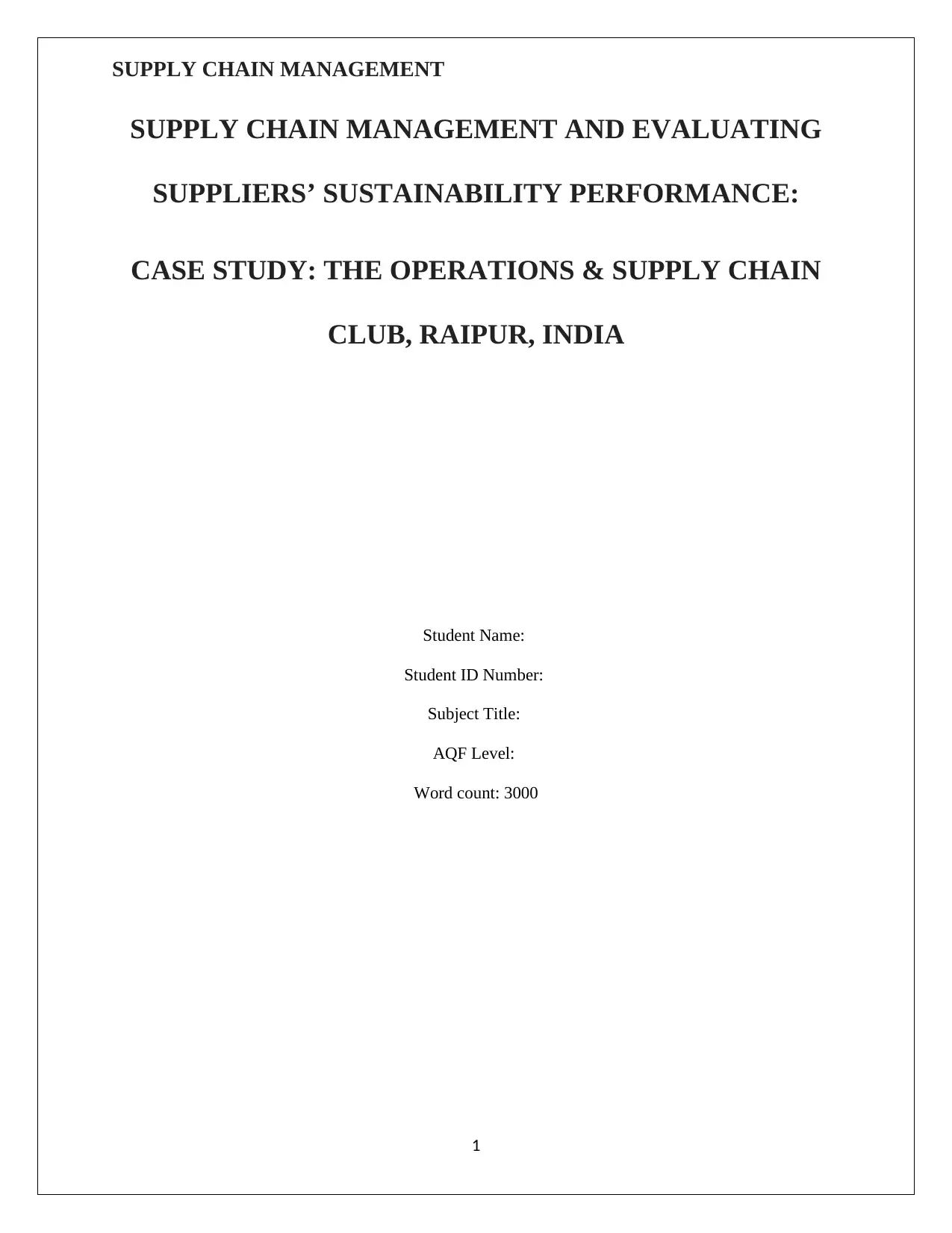
SUPPLY CHAIN MANAGEMENT
SUPPLY CHAIN MANAGEMENT AND EVALUATING
SUPPLIERS’ SUSTAINABILITY PERFORMANCE:
CASE STUDY: THE OPERATIONS & SUPPLY CHAIN
CLUB, RAIPUR, INDIA
Student Name:
Student ID Number:
Subject Title:
AQF Level:
Word count: 3000
1
SUPPLY CHAIN MANAGEMENT AND EVALUATING
SUPPLIERS’ SUSTAINABILITY PERFORMANCE:
CASE STUDY: THE OPERATIONS & SUPPLY CHAIN
CLUB, RAIPUR, INDIA
Student Name:
Student ID Number:
Subject Title:
AQF Level:
Word count: 3000
1
Secure Best Marks with AI Grader
Need help grading? Try our AI Grader for instant feedback on your assignments.
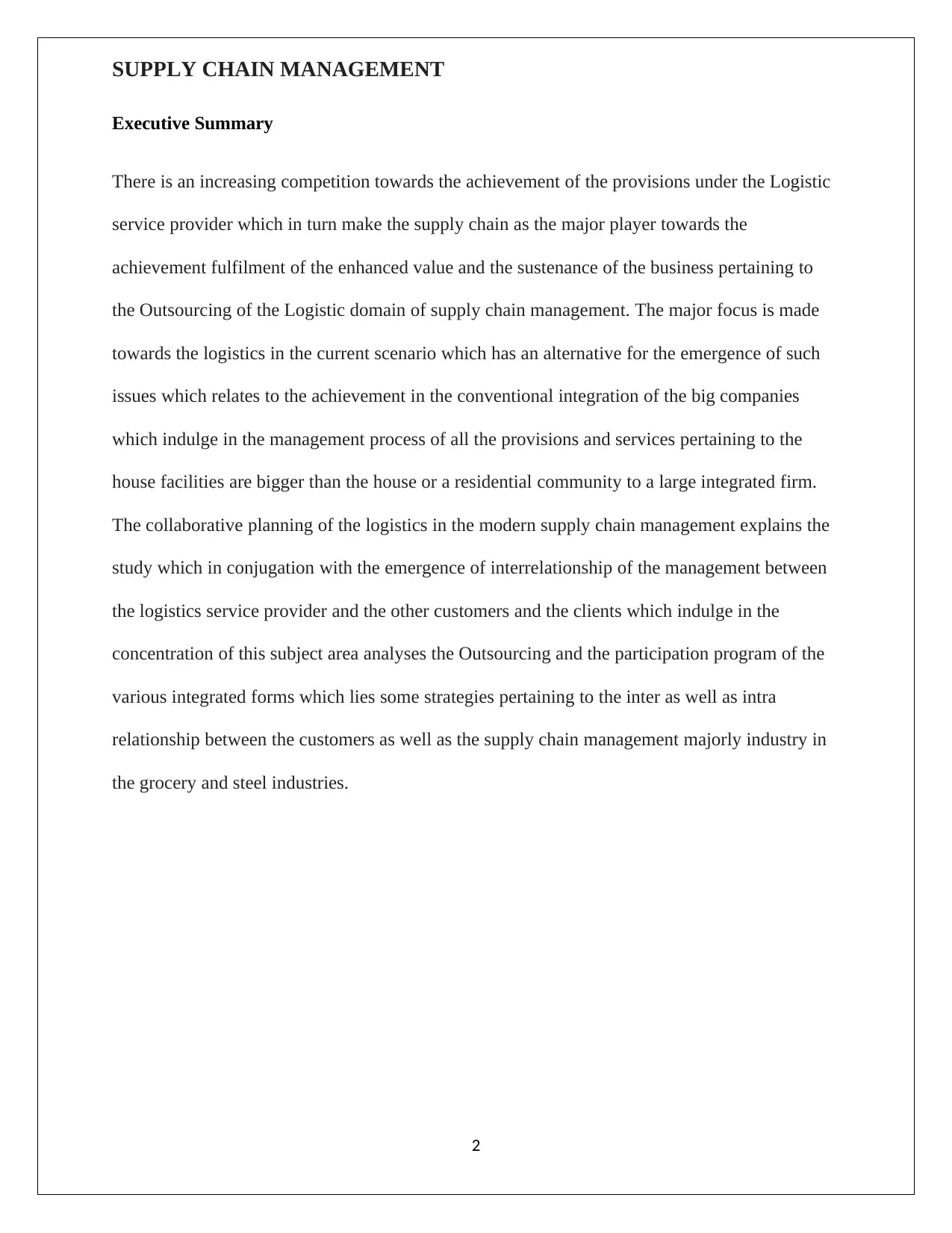
SUPPLY CHAIN MANAGEMENT
Executive Summary
There is an increasing competition towards the achievement of the provisions under the Logistic
service provider which in turn make the supply chain as the major player towards the
achievement fulfilment of the enhanced value and the sustenance of the business pertaining to
the Outsourcing of the Logistic domain of supply chain management. The major focus is made
towards the logistics in the current scenario which has an alternative for the emergence of such
issues which relates to the achievement in the conventional integration of the big companies
which indulge in the management process of all the provisions and services pertaining to the
house facilities are bigger than the house or a residential community to a large integrated firm.
The collaborative planning of the logistics in the modern supply chain management explains the
study which in conjugation with the emergence of interrelationship of the management between
the logistics service provider and the other customers and the clients which indulge in the
concentration of this subject area analyses the Outsourcing and the participation program of the
various integrated forms which lies some strategies pertaining to the inter as well as intra
relationship between the customers as well as the supply chain management majorly industry in
the grocery and steel industries.
2
Executive Summary
There is an increasing competition towards the achievement of the provisions under the Logistic
service provider which in turn make the supply chain as the major player towards the
achievement fulfilment of the enhanced value and the sustenance of the business pertaining to
the Outsourcing of the Logistic domain of supply chain management. The major focus is made
towards the logistics in the current scenario which has an alternative for the emergence of such
issues which relates to the achievement in the conventional integration of the big companies
which indulge in the management process of all the provisions and services pertaining to the
house facilities are bigger than the house or a residential community to a large integrated firm.
The collaborative planning of the logistics in the modern supply chain management explains the
study which in conjugation with the emergence of interrelationship of the management between
the logistics service provider and the other customers and the clients which indulge in the
concentration of this subject area analyses the Outsourcing and the participation program of the
various integrated forms which lies some strategies pertaining to the inter as well as intra
relationship between the customers as well as the supply chain management majorly industry in
the grocery and steel industries.
2
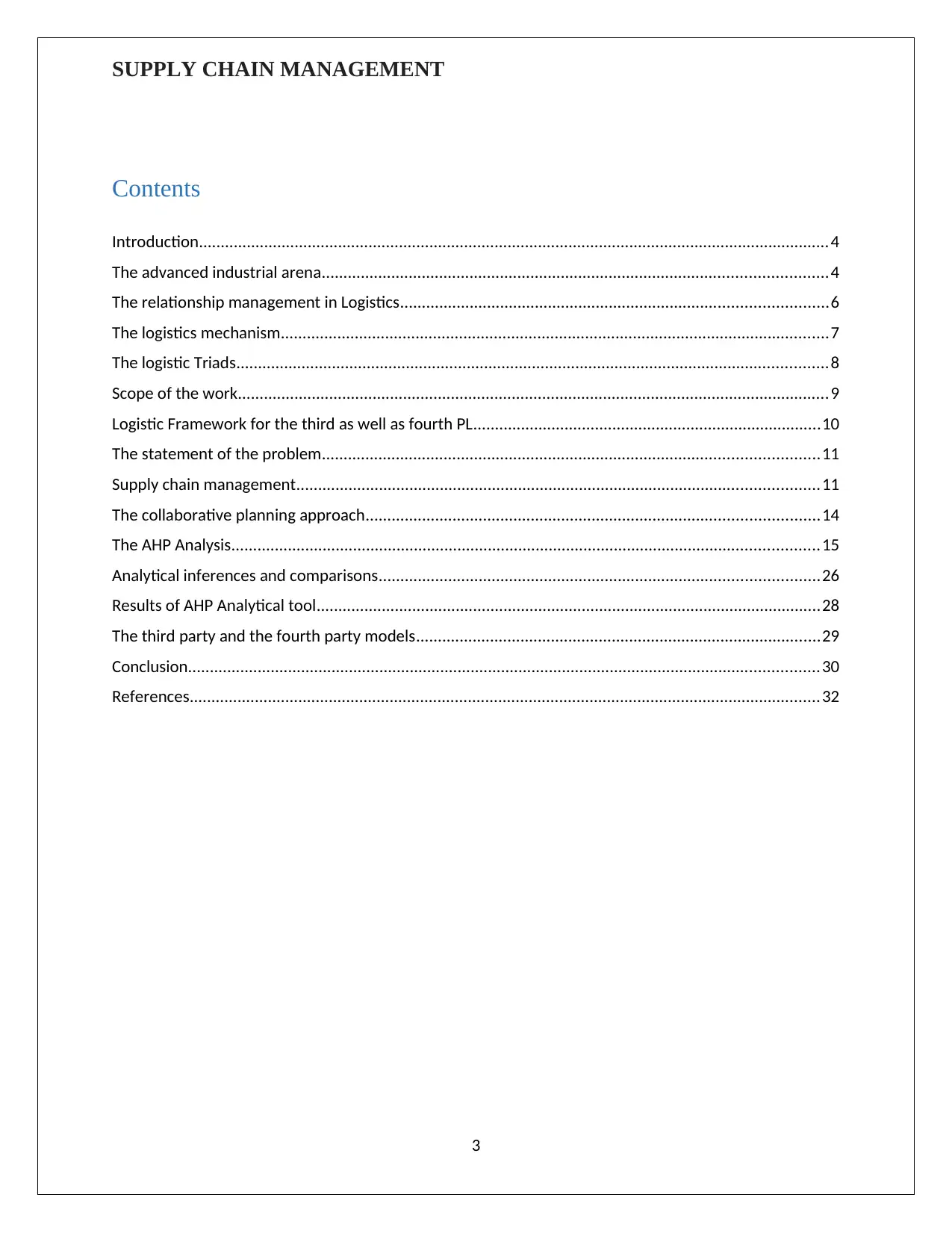
SUPPLY CHAIN MANAGEMENT
Contents
Introduction.................................................................................................................................................4
The advanced industrial arena....................................................................................................................4
The relationship management in Logistics..................................................................................................6
The logistics mechanism..............................................................................................................................7
The logistic Triads........................................................................................................................................8
Scope of the work........................................................................................................................................9
Logistic Framework for the third as well as fourth PL................................................................................10
The statement of the problem..................................................................................................................11
Supply chain management........................................................................................................................11
The collaborative planning approach........................................................................................................14
The AHP Analysis.......................................................................................................................................15
Analytical inferences and comparisons.....................................................................................................26
Results of AHP Analytical tool....................................................................................................................28
The third party and the fourth party models.............................................................................................29
Conclusion.................................................................................................................................................30
References.................................................................................................................................................32
3
Contents
Introduction.................................................................................................................................................4
The advanced industrial arena....................................................................................................................4
The relationship management in Logistics..................................................................................................6
The logistics mechanism..............................................................................................................................7
The logistic Triads........................................................................................................................................8
Scope of the work........................................................................................................................................9
Logistic Framework for the third as well as fourth PL................................................................................10
The statement of the problem..................................................................................................................11
Supply chain management........................................................................................................................11
The collaborative planning approach........................................................................................................14
The AHP Analysis.......................................................................................................................................15
Analytical inferences and comparisons.....................................................................................................26
Results of AHP Analytical tool....................................................................................................................28
The third party and the fourth party models.............................................................................................29
Conclusion.................................................................................................................................................30
References.................................................................................................................................................32
3
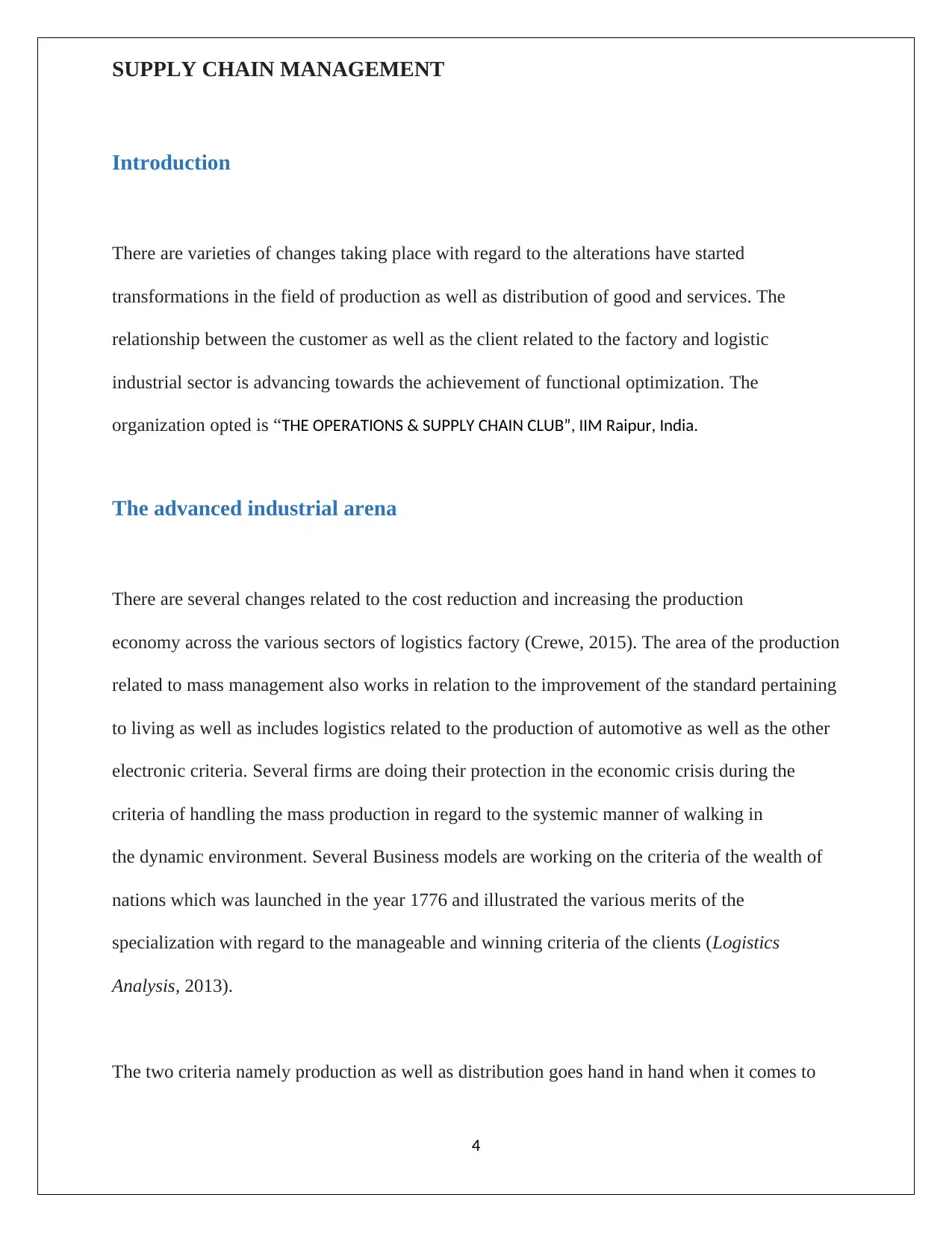
SUPPLY CHAIN MANAGEMENT
Introduction
There are varieties of changes taking place with regard to the alterations have started
transformations in the field of production as well as distribution of good and services. The
relationship between the customer as well as the client related to the factory and logistic
industrial sector is advancing towards the achievement of functional optimization. The
organization opted is “THE OPERATIONS & SUPPLY CHAIN CLUB”, IIM Raipur, India.
The advanced industrial arena
There are several changes related to the cost reduction and increasing the production
economy across the various sectors of logistics factory (Crewe, 2015). The area of the production
related to mass management also works in relation to the improvement of the standard pertaining
to living as well as includes logistics related to the production of automotive as well as the other
electronic criteria. Several firms are doing their protection in the economic crisis during the
criteria of handling the mass production in regard to the systemic manner of walking in
the dynamic environment. Several Business models are working on the criteria of the wealth of
nations which was launched in the year 1776 and illustrated the various merits of the
specialization with regard to the manageable and winning criteria of the clients (Logistics
Analysis, 2013).
The two criteria namely production as well as distribution goes hand in hand when it comes to
4
Introduction
There are varieties of changes taking place with regard to the alterations have started
transformations in the field of production as well as distribution of good and services. The
relationship between the customer as well as the client related to the factory and logistic
industrial sector is advancing towards the achievement of functional optimization. The
organization opted is “THE OPERATIONS & SUPPLY CHAIN CLUB”, IIM Raipur, India.
The advanced industrial arena
There are several changes related to the cost reduction and increasing the production
economy across the various sectors of logistics factory (Crewe, 2015). The area of the production
related to mass management also works in relation to the improvement of the standard pertaining
to living as well as includes logistics related to the production of automotive as well as the other
electronic criteria. Several firms are doing their protection in the economic crisis during the
criteria of handling the mass production in regard to the systemic manner of walking in
the dynamic environment. Several Business models are working on the criteria of the wealth of
nations which was launched in the year 1776 and illustrated the various merits of the
specialization with regard to the manageable and winning criteria of the clients (Logistics
Analysis, 2013).
The two criteria namely production as well as distribution goes hand in hand when it comes to
4
Secure Best Marks with AI Grader
Need help grading? Try our AI Grader for instant feedback on your assignments.

SUPPLY CHAIN MANAGEMENT
the fulfilment of the demands of the customers and other clients in relation to the ends of the
supply chain network. The coincidence is also drawn on the basis of behavior of the industries
which entirely manages the production sales and other woman genius market tactics in the
individualistic and holistic approach. In various sectors where the integrated vertical forms are
working on the bespoke services such as the tailor making suits and other criteria Defined by the
pricing as well as efficiency drawn by the market dynamics.
The relationship management in Logistics
The delivery of the mechanisms inside the requirement of the partnership orientation with regard
to the Logistic supply chain network is acting as the driver of the differentiation caused with
regard to the manufacturer's product orientation of the goods and services which can become
more specialized in the modern competent environment so as to make the working more
descriptive as well as more enhanced in the Outsourcing of the Other elements that act as the
fundamental and significant property for the equipment of the decision making process and
relationship management in the logistics service provider (Coron, 2014).
The logistics mechanism
The various processes which include the development as well as the management of the
demanding criteria with relation to the several aspects in the certain it is of the management of
the dynamic relationship such as the Logistic triad and the Logistic dyad. The exploration which
5
the fulfilment of the demands of the customers and other clients in relation to the ends of the
supply chain network. The coincidence is also drawn on the basis of behavior of the industries
which entirely manages the production sales and other woman genius market tactics in the
individualistic and holistic approach. In various sectors where the integrated vertical forms are
working on the bespoke services such as the tailor making suits and other criteria Defined by the
pricing as well as efficiency drawn by the market dynamics.
The relationship management in Logistics
The delivery of the mechanisms inside the requirement of the partnership orientation with regard
to the Logistic supply chain network is acting as the driver of the differentiation caused with
regard to the manufacturer's product orientation of the goods and services which can become
more specialized in the modern competent environment so as to make the working more
descriptive as well as more enhanced in the Outsourcing of the Other elements that act as the
fundamental and significant property for the equipment of the decision making process and
relationship management in the logistics service provider (Coron, 2014).
The logistics mechanism
The various processes which include the development as well as the management of the
demanding criteria with relation to the several aspects in the certain it is of the management of
the dynamic relationship such as the Logistic triad and the Logistic dyad. The exploration which
5
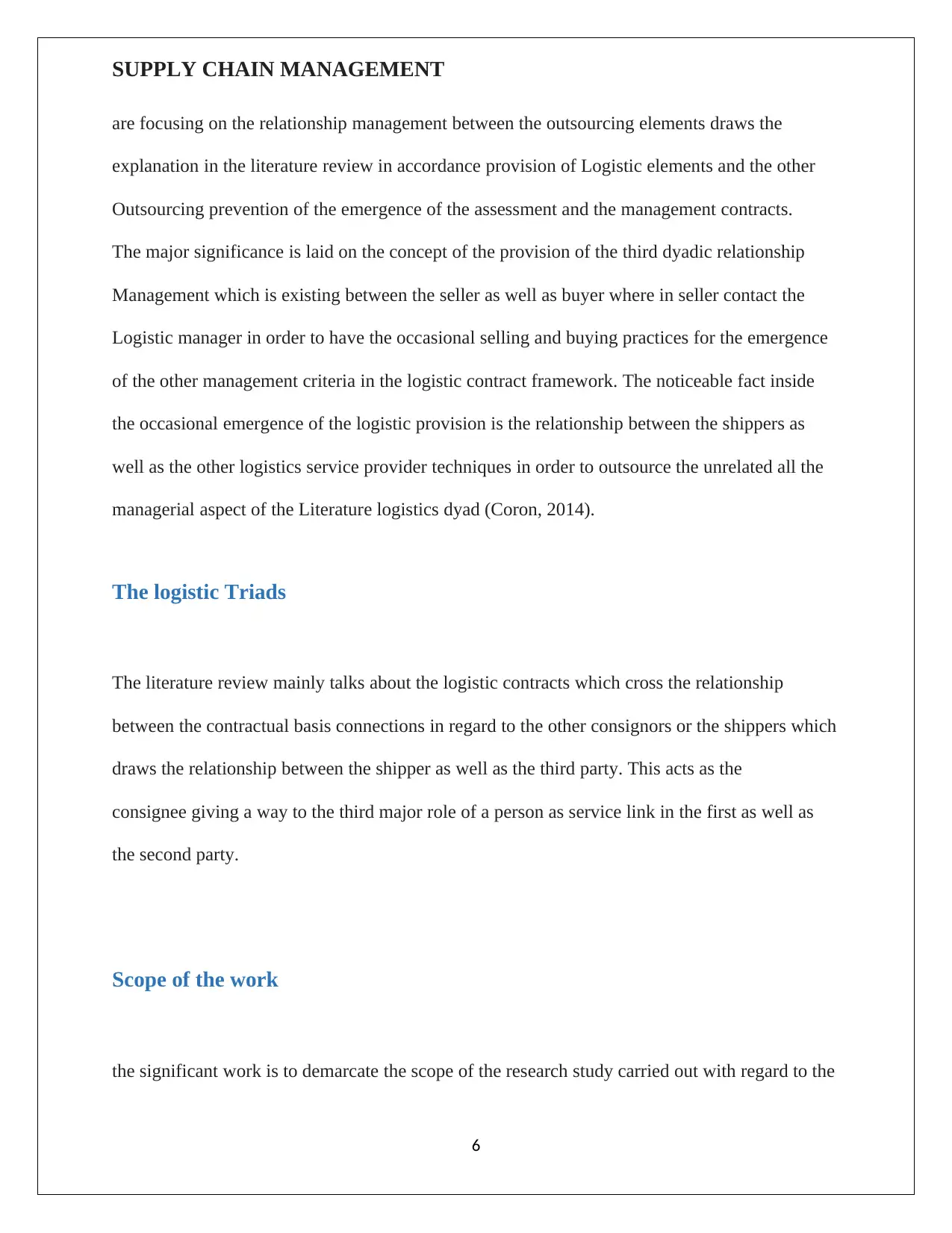
SUPPLY CHAIN MANAGEMENT
are focusing on the relationship management between the outsourcing elements draws the
explanation in the literature review in accordance provision of Logistic elements and the other
Outsourcing prevention of the emergence of the assessment and the management contracts.
The major significance is laid on the concept of the provision of the third dyadic relationship
Management which is existing between the seller as well as buyer where in seller contact the
Logistic manager in order to have the occasional selling and buying practices for the emergence
of the other management criteria in the logistic contract framework. The noticeable fact inside
the occasional emergence of the logistic provision is the relationship between the shippers as
well as the other logistics service provider techniques in order to outsource the unrelated all the
managerial aspect of the Literature logistics dyad (Coron, 2014).
The logistic Triads
The literature review mainly talks about the logistic contracts which cross the relationship
between the contractual basis connections in regard to the other consignors or the shippers which
draws the relationship between the shipper as well as the third party. This acts as the
consignee giving a way to the third major role of a person as service link in the first as well as
the second party.
Scope of the work
the significant work is to demarcate the scope of the research study carried out with regard to the
6
are focusing on the relationship management between the outsourcing elements draws the
explanation in the literature review in accordance provision of Logistic elements and the other
Outsourcing prevention of the emergence of the assessment and the management contracts.
The major significance is laid on the concept of the provision of the third dyadic relationship
Management which is existing between the seller as well as buyer where in seller contact the
Logistic manager in order to have the occasional selling and buying practices for the emergence
of the other management criteria in the logistic contract framework. The noticeable fact inside
the occasional emergence of the logistic provision is the relationship between the shippers as
well as the other logistics service provider techniques in order to outsource the unrelated all the
managerial aspect of the Literature logistics dyad (Coron, 2014).
The logistic Triads
The literature review mainly talks about the logistic contracts which cross the relationship
between the contractual basis connections in regard to the other consignors or the shippers which
draws the relationship between the shipper as well as the third party. This acts as the
consignee giving a way to the third major role of a person as service link in the first as well as
the second party.
Scope of the work
the significant work is to demarcate the scope of the research study carried out with regard to the
6
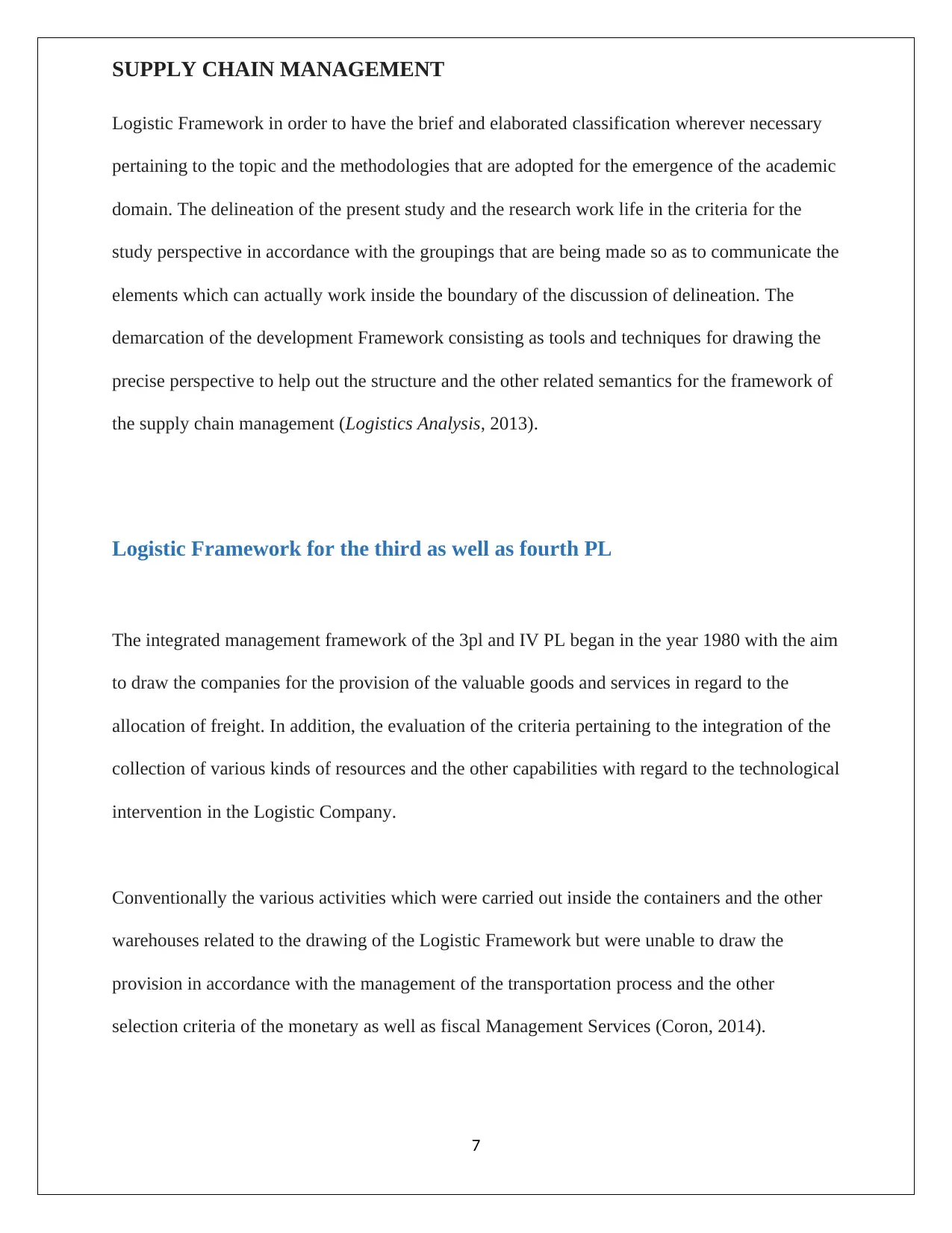
SUPPLY CHAIN MANAGEMENT
Logistic Framework in order to have the brief and elaborated classification wherever necessary
pertaining to the topic and the methodologies that are adopted for the emergence of the academic
domain. The delineation of the present study and the research work life in the criteria for the
study perspective in accordance with the groupings that are being made so as to communicate the
elements which can actually work inside the boundary of the discussion of delineation. The
demarcation of the development Framework consisting as tools and techniques for drawing the
precise perspective to help out the structure and the other related semantics for the framework of
the supply chain management (Logistics Analysis, 2013).
Logistic Framework for the third as well as fourth PL
The integrated management framework of the 3pl and IV PL began in the year 1980 with the aim
to draw the companies for the provision of the valuable goods and services in regard to the
allocation of freight. In addition, the evaluation of the criteria pertaining to the integration of the
collection of various kinds of resources and the other capabilities with regard to the technological
intervention in the Logistic Company.
Conventionally the various activities which were carried out inside the containers and the other
warehouses related to the drawing of the Logistic Framework but were unable to draw the
provision in accordance with the management of the transportation process and the other
selection criteria of the monetary as well as fiscal Management Services (Coron, 2014).
7
Logistic Framework in order to have the brief and elaborated classification wherever necessary
pertaining to the topic and the methodologies that are adopted for the emergence of the academic
domain. The delineation of the present study and the research work life in the criteria for the
study perspective in accordance with the groupings that are being made so as to communicate the
elements which can actually work inside the boundary of the discussion of delineation. The
demarcation of the development Framework consisting as tools and techniques for drawing the
precise perspective to help out the structure and the other related semantics for the framework of
the supply chain management (Logistics Analysis, 2013).
Logistic Framework for the third as well as fourth PL
The integrated management framework of the 3pl and IV PL began in the year 1980 with the aim
to draw the companies for the provision of the valuable goods and services in regard to the
allocation of freight. In addition, the evaluation of the criteria pertaining to the integration of the
collection of various kinds of resources and the other capabilities with regard to the technological
intervention in the Logistic Company.
Conventionally the various activities which were carried out inside the containers and the other
warehouses related to the drawing of the Logistic Framework but were unable to draw the
provision in accordance with the management of the transportation process and the other
selection criteria of the monetary as well as fiscal Management Services (Coron, 2014).
7
Paraphrase This Document
Need a fresh take? Get an instant paraphrase of this document with our AI Paraphraser
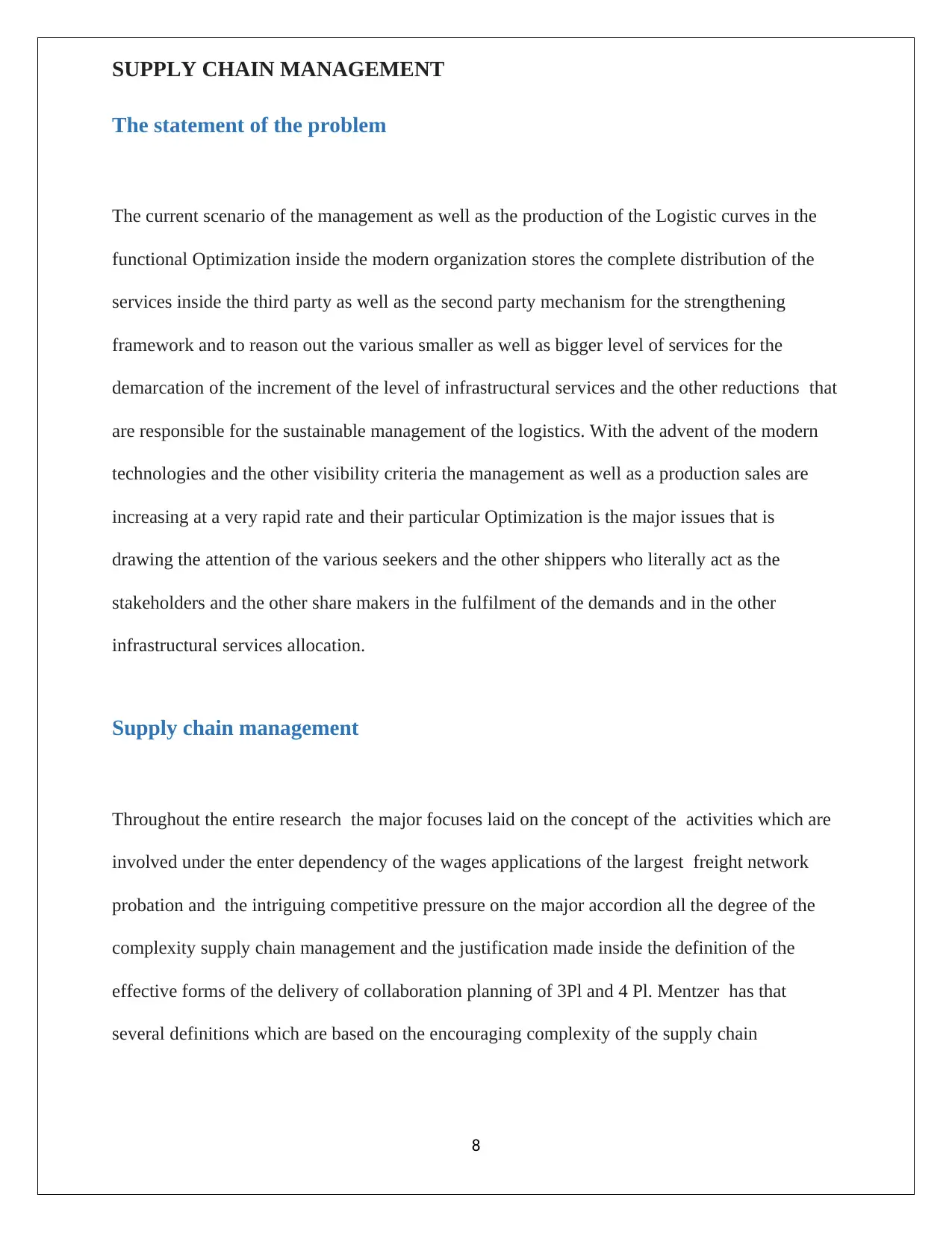
SUPPLY CHAIN MANAGEMENT
The statement of the problem
The current scenario of the management as well as the production of the Logistic curves in the
functional Optimization inside the modern organization stores the complete distribution of the
services inside the third party as well as the second party mechanism for the strengthening
framework and to reason out the various smaller as well as bigger level of services for the
demarcation of the increment of the level of infrastructural services and the other reductions that
are responsible for the sustainable management of the logistics. With the advent of the modern
technologies and the other visibility criteria the management as well as a production sales are
increasing at a very rapid rate and their particular Optimization is the major issues that is
drawing the attention of the various seekers and the other shippers who literally act as the
stakeholders and the other share makers in the fulfilment of the demands and in the other
infrastructural services allocation.
Supply chain management
Throughout the entire research the major focuses laid on the concept of the activities which are
involved under the enter dependency of the wages applications of the largest freight network
probation and the intriguing competitive pressure on the major accordion all the degree of the
complexity supply chain management and the justification made inside the definition of the
effective forms of the delivery of collaboration planning of 3Pl and 4 Pl. Mentzer has that
several definitions which are based on the encouraging complexity of the supply chain
8
The statement of the problem
The current scenario of the management as well as the production of the Logistic curves in the
functional Optimization inside the modern organization stores the complete distribution of the
services inside the third party as well as the second party mechanism for the strengthening
framework and to reason out the various smaller as well as bigger level of services for the
demarcation of the increment of the level of infrastructural services and the other reductions that
are responsible for the sustainable management of the logistics. With the advent of the modern
technologies and the other visibility criteria the management as well as a production sales are
increasing at a very rapid rate and their particular Optimization is the major issues that is
drawing the attention of the various seekers and the other shippers who literally act as the
stakeholders and the other share makers in the fulfilment of the demands and in the other
infrastructural services allocation.
Supply chain management
Throughout the entire research the major focuses laid on the concept of the activities which are
involved under the enter dependency of the wages applications of the largest freight network
probation and the intriguing competitive pressure on the major accordion all the degree of the
complexity supply chain management and the justification made inside the definition of the
effective forms of the delivery of collaboration planning of 3Pl and 4 Pl. Mentzer has that
several definitions which are based on the encouraging complexity of the supply chain
8
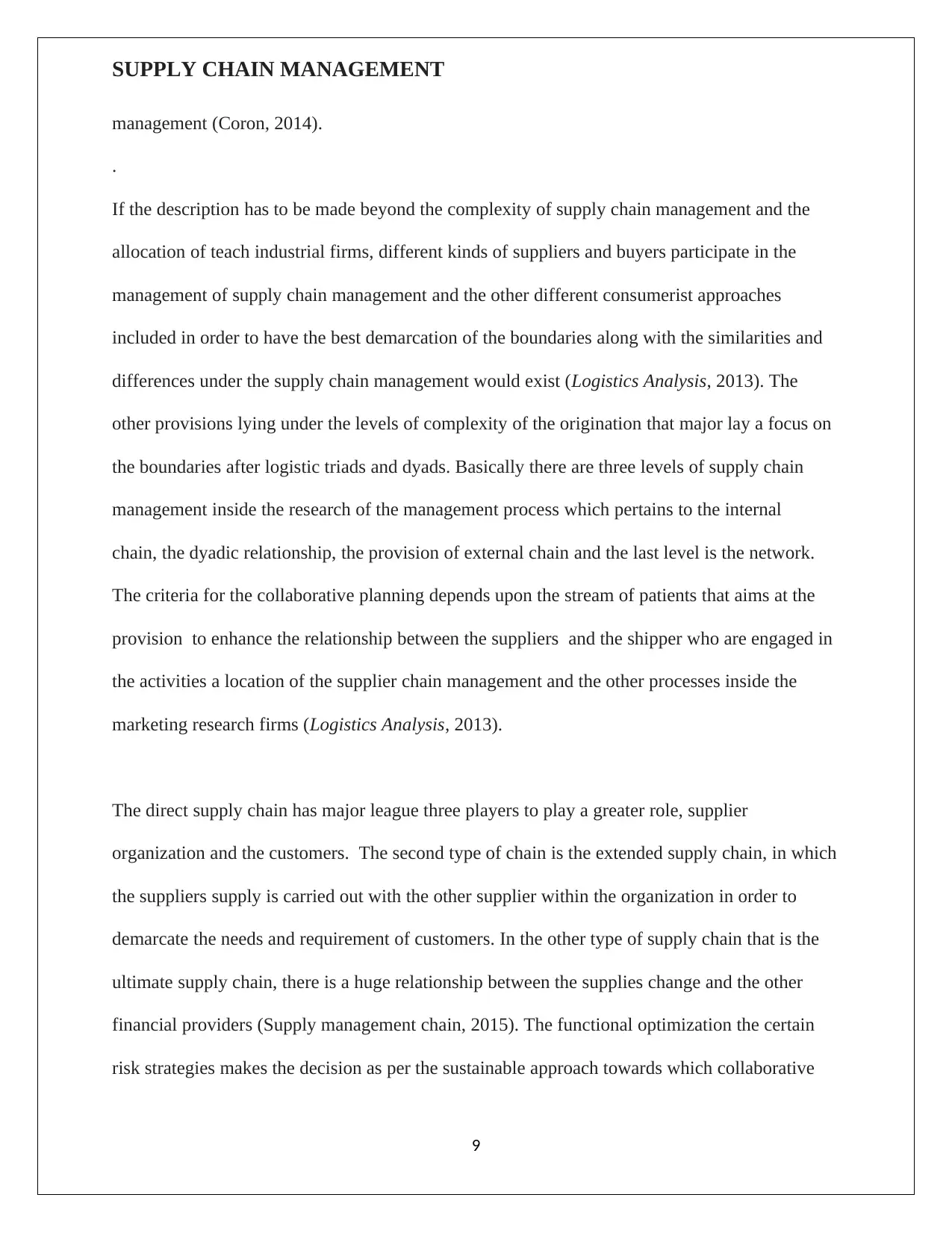
SUPPLY CHAIN MANAGEMENT
management (Coron, 2014).
.
If the description has to be made beyond the complexity of supply chain management and the
allocation of teach industrial firms, different kinds of suppliers and buyers participate in the
management of supply chain management and the other different consumerist approaches
included in order to have the best demarcation of the boundaries along with the similarities and
differences under the supply chain management would exist (Logistics Analysis, 2013). The
other provisions lying under the levels of complexity of the origination that major lay a focus on
the boundaries after logistic triads and dyads. Basically there are three levels of supply chain
management inside the research of the management process which pertains to the internal
chain, the dyadic relationship, the provision of external chain and the last level is the network.
The criteria for the collaborative planning depends upon the stream of patients that aims at the
provision to enhance the relationship between the suppliers and the shipper who are engaged in
the activities a location of the supplier chain management and the other processes inside the
marketing research firms (Logistics Analysis, 2013).
The direct supply chain has major league three players to play a greater role, supplier
organization and the customers. The second type of chain is the extended supply chain, in which
the suppliers supply is carried out with the other supplier within the organization in order to
demarcate the needs and requirement of customers. In the other type of supply chain that is the
ultimate supply chain, there is a huge relationship between the supplies change and the other
financial providers (Supply management chain, 2015). The functional optimization the certain
risk strategies makes the decision as per the sustainable approach towards which collaborative
9
management (Coron, 2014).
.
If the description has to be made beyond the complexity of supply chain management and the
allocation of teach industrial firms, different kinds of suppliers and buyers participate in the
management of supply chain management and the other different consumerist approaches
included in order to have the best demarcation of the boundaries along with the similarities and
differences under the supply chain management would exist (Logistics Analysis, 2013). The
other provisions lying under the levels of complexity of the origination that major lay a focus on
the boundaries after logistic triads and dyads. Basically there are three levels of supply chain
management inside the research of the management process which pertains to the internal
chain, the dyadic relationship, the provision of external chain and the last level is the network.
The criteria for the collaborative planning depends upon the stream of patients that aims at the
provision to enhance the relationship between the suppliers and the shipper who are engaged in
the activities a location of the supplier chain management and the other processes inside the
marketing research firms (Logistics Analysis, 2013).
The direct supply chain has major league three players to play a greater role, supplier
organization and the customers. The second type of chain is the extended supply chain, in which
the suppliers supply is carried out with the other supplier within the organization in order to
demarcate the needs and requirement of customers. In the other type of supply chain that is the
ultimate supply chain, there is a huge relationship between the supplies change and the other
financial providers (Supply management chain, 2015). The functional optimization the certain
risk strategies makes the decision as per the sustainable approach towards which collaborative
9
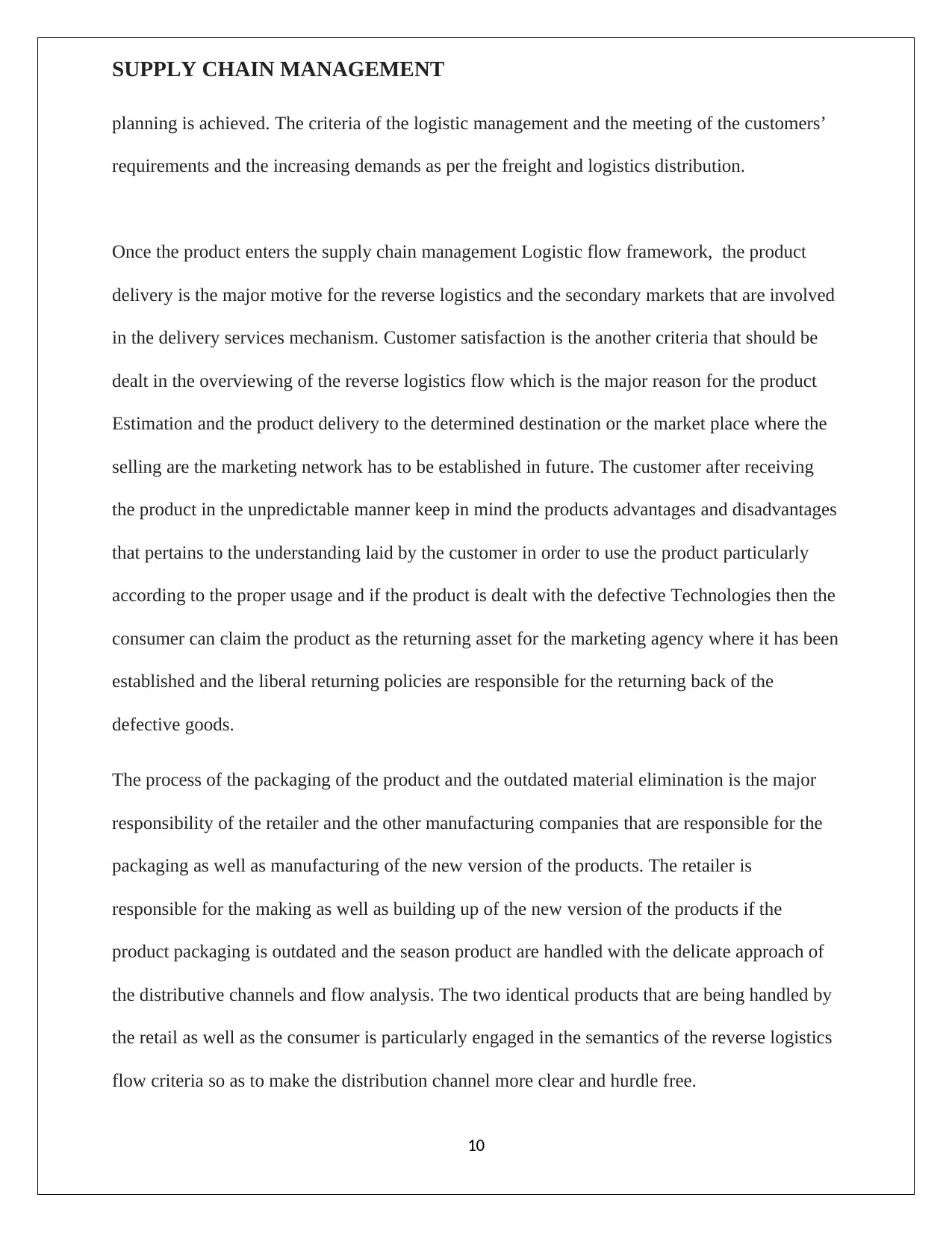
SUPPLY CHAIN MANAGEMENT
planning is achieved. The criteria of the logistic management and the meeting of the customers’
requirements and the increasing demands as per the freight and logistics distribution.
Once the product enters the supply chain management Logistic flow framework, the product
delivery is the major motive for the reverse logistics and the secondary markets that are involved
in the delivery services mechanism. Customer satisfaction is the another criteria that should be
dealt in the overviewing of the reverse logistics flow which is the major reason for the product
Estimation and the product delivery to the determined destination or the market place where the
selling are the marketing network has to be established in future. The customer after receiving
the product in the unpredictable manner keep in mind the products advantages and disadvantages
that pertains to the understanding laid by the customer in order to use the product particularly
according to the proper usage and if the product is dealt with the defective Technologies then the
consumer can claim the product as the returning asset for the marketing agency where it has been
established and the liberal returning policies are responsible for the returning back of the
defective goods.
The process of the packaging of the product and the outdated material elimination is the major
responsibility of the retailer and the other manufacturing companies that are responsible for the
packaging as well as manufacturing of the new version of the products. The retailer is
responsible for the making as well as building up of the new version of the products if the
product packaging is outdated and the season product are handled with the delicate approach of
the distributive channels and flow analysis. The two identical products that are being handled by
the retail as well as the consumer is particularly engaged in the semantics of the reverse logistics
flow criteria so as to make the distribution channel more clear and hurdle free.
10
planning is achieved. The criteria of the logistic management and the meeting of the customers’
requirements and the increasing demands as per the freight and logistics distribution.
Once the product enters the supply chain management Logistic flow framework, the product
delivery is the major motive for the reverse logistics and the secondary markets that are involved
in the delivery services mechanism. Customer satisfaction is the another criteria that should be
dealt in the overviewing of the reverse logistics flow which is the major reason for the product
Estimation and the product delivery to the determined destination or the market place where the
selling are the marketing network has to be established in future. The customer after receiving
the product in the unpredictable manner keep in mind the products advantages and disadvantages
that pertains to the understanding laid by the customer in order to use the product particularly
according to the proper usage and if the product is dealt with the defective Technologies then the
consumer can claim the product as the returning asset for the marketing agency where it has been
established and the liberal returning policies are responsible for the returning back of the
defective goods.
The process of the packaging of the product and the outdated material elimination is the major
responsibility of the retailer and the other manufacturing companies that are responsible for the
packaging as well as manufacturing of the new version of the products. The retailer is
responsible for the making as well as building up of the new version of the products if the
product packaging is outdated and the season product are handled with the delicate approach of
the distributive channels and flow analysis. The two identical products that are being handled by
the retail as well as the consumer is particularly engaged in the semantics of the reverse logistics
flow criteria so as to make the distribution channel more clear and hurdle free.
10
Secure Best Marks with AI Grader
Need help grading? Try our AI Grader for instant feedback on your assignments.
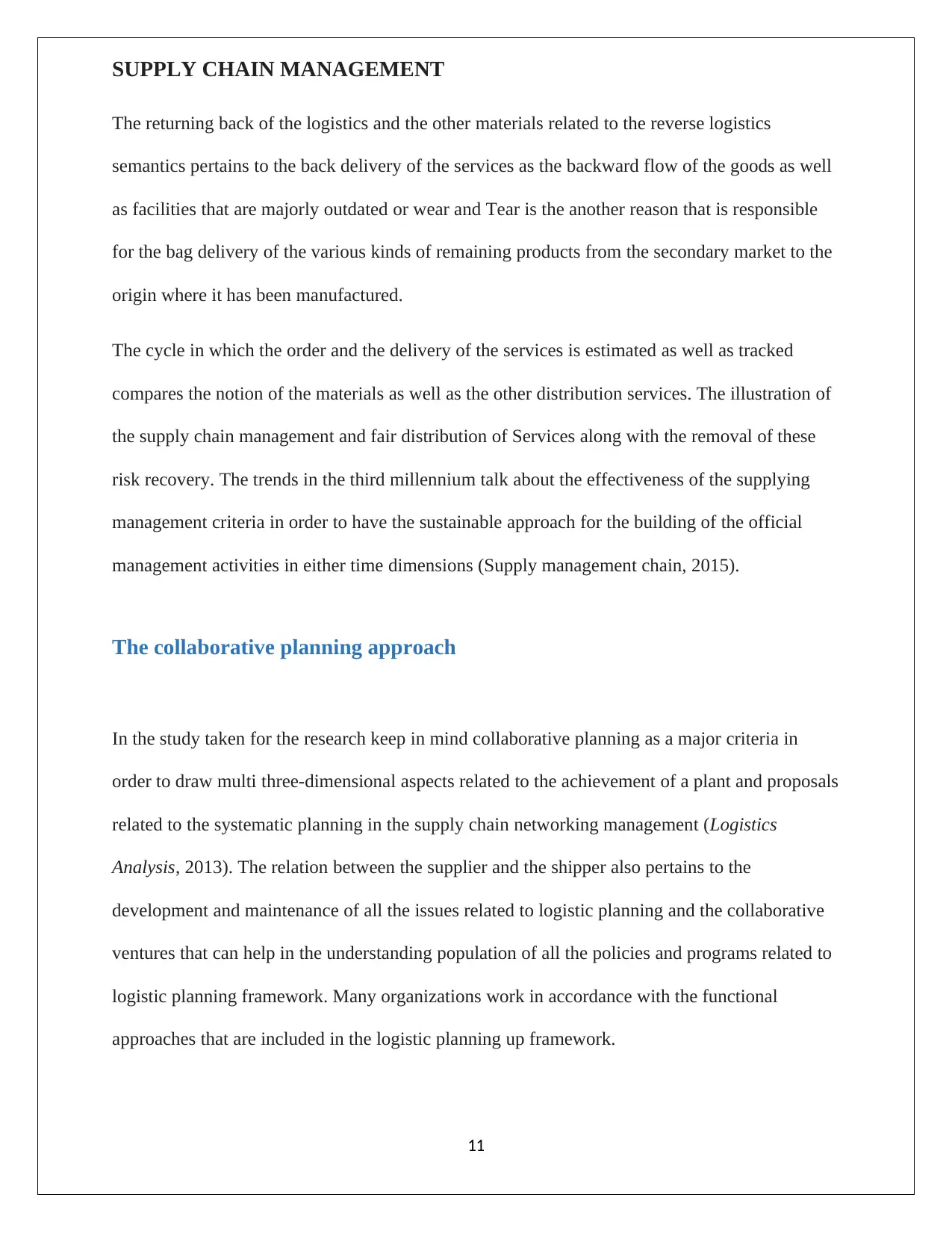
SUPPLY CHAIN MANAGEMENT
The returning back of the logistics and the other materials related to the reverse logistics
semantics pertains to the back delivery of the services as the backward flow of the goods as well
as facilities that are majorly outdated or wear and Tear is the another reason that is responsible
for the bag delivery of the various kinds of remaining products from the secondary market to the
origin where it has been manufactured.
The cycle in which the order and the delivery of the services is estimated as well as tracked
compares the notion of the materials as well as the other distribution services. The illustration of
the supply chain management and fair distribution of Services along with the removal of these
risk recovery. The trends in the third millennium talk about the effectiveness of the supplying
management criteria in order to have the sustainable approach for the building of the official
management activities in either time dimensions (Supply management chain, 2015).
The collaborative planning approach
In the study taken for the research keep in mind collaborative planning as a major criteria in
order to draw multi three-dimensional aspects related to the achievement of a plant and proposals
related to the systematic planning in the supply chain networking management (Logistics
Analysis, 2013). The relation between the supplier and the shipper also pertains to the
development and maintenance of all the issues related to logistic planning and the collaborative
ventures that can help in the understanding population of all the policies and programs related to
logistic planning framework. Many organizations work in accordance with the functional
approaches that are included in the logistic planning up framework.
11
The returning back of the logistics and the other materials related to the reverse logistics
semantics pertains to the back delivery of the services as the backward flow of the goods as well
as facilities that are majorly outdated or wear and Tear is the another reason that is responsible
for the bag delivery of the various kinds of remaining products from the secondary market to the
origin where it has been manufactured.
The cycle in which the order and the delivery of the services is estimated as well as tracked
compares the notion of the materials as well as the other distribution services. The illustration of
the supply chain management and fair distribution of Services along with the removal of these
risk recovery. The trends in the third millennium talk about the effectiveness of the supplying
management criteria in order to have the sustainable approach for the building of the official
management activities in either time dimensions (Supply management chain, 2015).
The collaborative planning approach
In the study taken for the research keep in mind collaborative planning as a major criteria in
order to draw multi three-dimensional aspects related to the achievement of a plant and proposals
related to the systematic planning in the supply chain networking management (Logistics
Analysis, 2013). The relation between the supplier and the shipper also pertains to the
development and maintenance of all the issues related to logistic planning and the collaborative
ventures that can help in the understanding population of all the policies and programs related to
logistic planning framework. Many organizations work in accordance with the functional
approaches that are included in the logistic planning up framework.
11

SUPPLY CHAIN MANAGEMENT
The AHP Analysis
Decision Making
Matrix
12
Objective
Criterion 1 Criterion 4Criterion 2 Criterion 3
A
C
B
A
C
B
A
C
B
A
cost
C
B
Criterion 1 Criterion 2 Criterion 3
Criterion 4
A
The AHP Analysis
Decision Making
Matrix
12
Objective
Criterion 1 Criterion 4Criterion 2 Criterion 3
A
C
B
A
C
B
A
C
B
A
cost
C
B
Criterion 1 Criterion 2 Criterion 3
Criterion 4
A
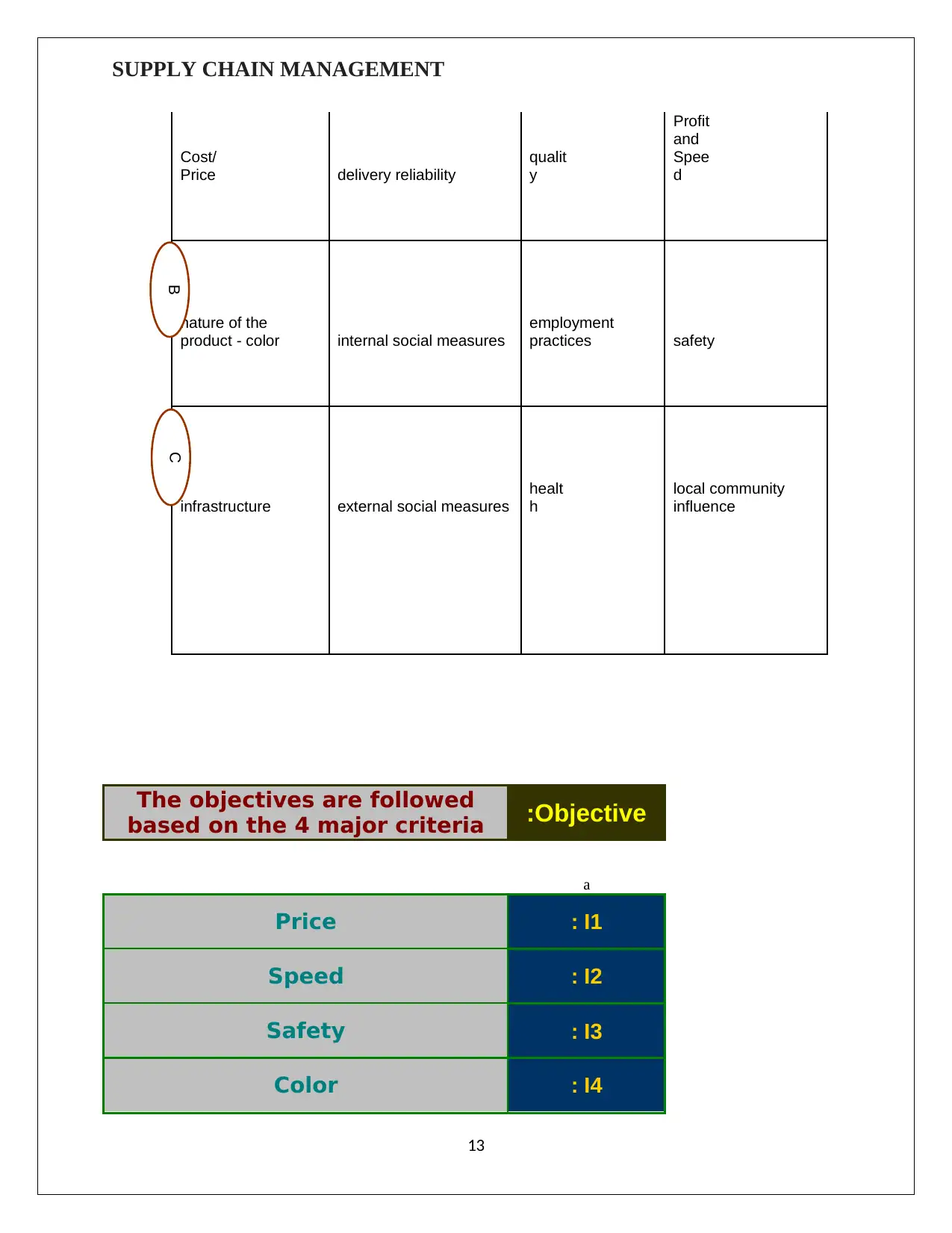
SUPPLY CHAIN MANAGEMENT
Cost/
Price delivery reliability
qualit
y
Profit
and
Spee
d
nature of the
product - color internal social measures
employment
practices safety
infrastructure external social measures
healt
h
local community
influence
The objectives are followed
based on the 4 major criteria :Objective
a
Price : I1
Speed : I2
Safety : I3
Color : I4
13
B C
Cost/
Price delivery reliability
qualit
y
Profit
and
Spee
d
nature of the
product - color internal social measures
employment
practices safety
infrastructure external social measures
healt
h
local community
influence
The objectives are followed
based on the 4 major criteria :Objective
a
Price : I1
Speed : I2
Safety : I3
Color : I4
13
B C
Paraphrase This Document
Need a fresh take? Get an instant paraphrase of this document with our AI Paraphraser
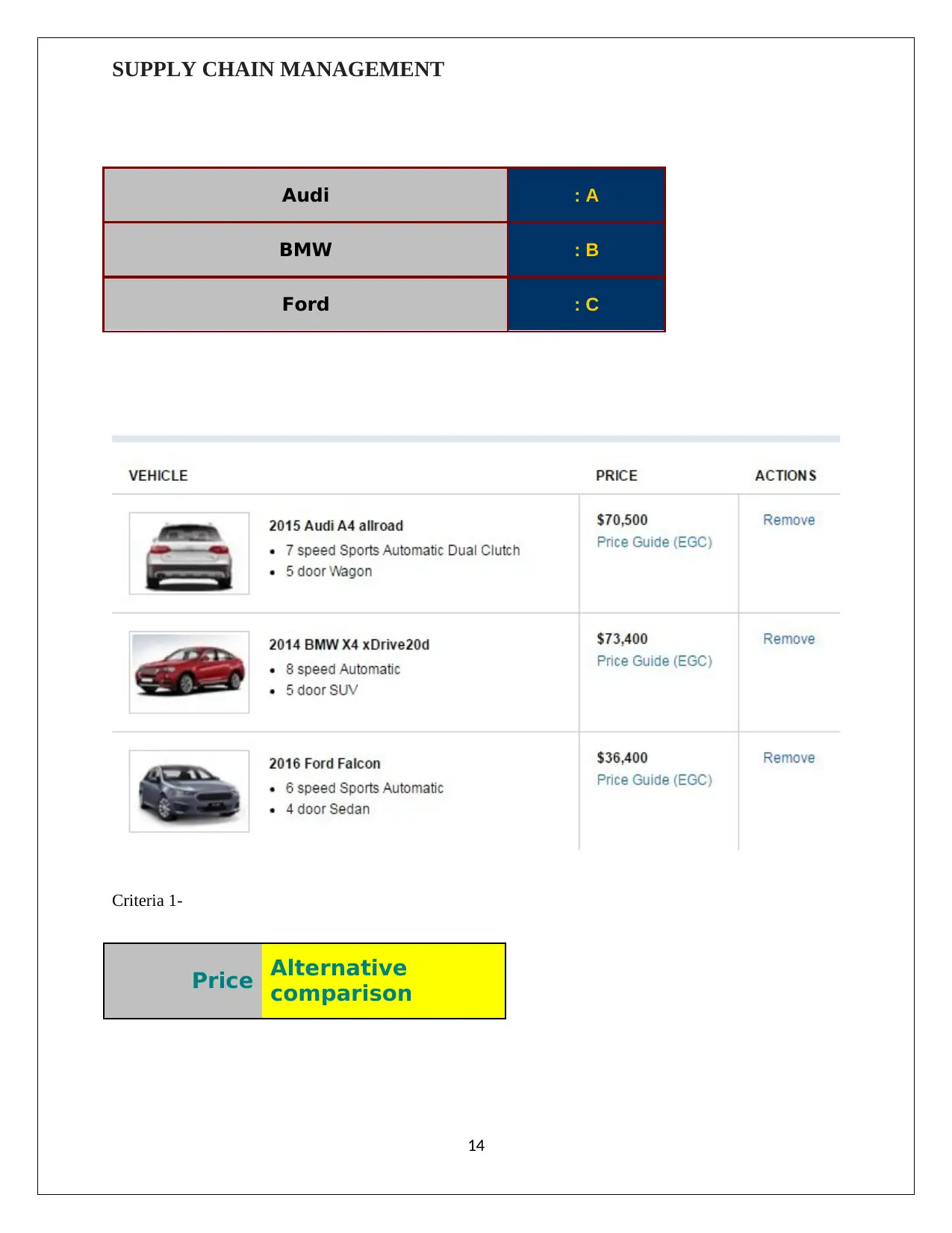
SUPPLY CHAIN MANAGEMENT
Audi : A
BMW : B
Ford : C
Criteria 1-
Price Alternative
comparison
14
Audi : A
BMW : B
Ford : C
Criteria 1-
Price Alternative
comparison
14
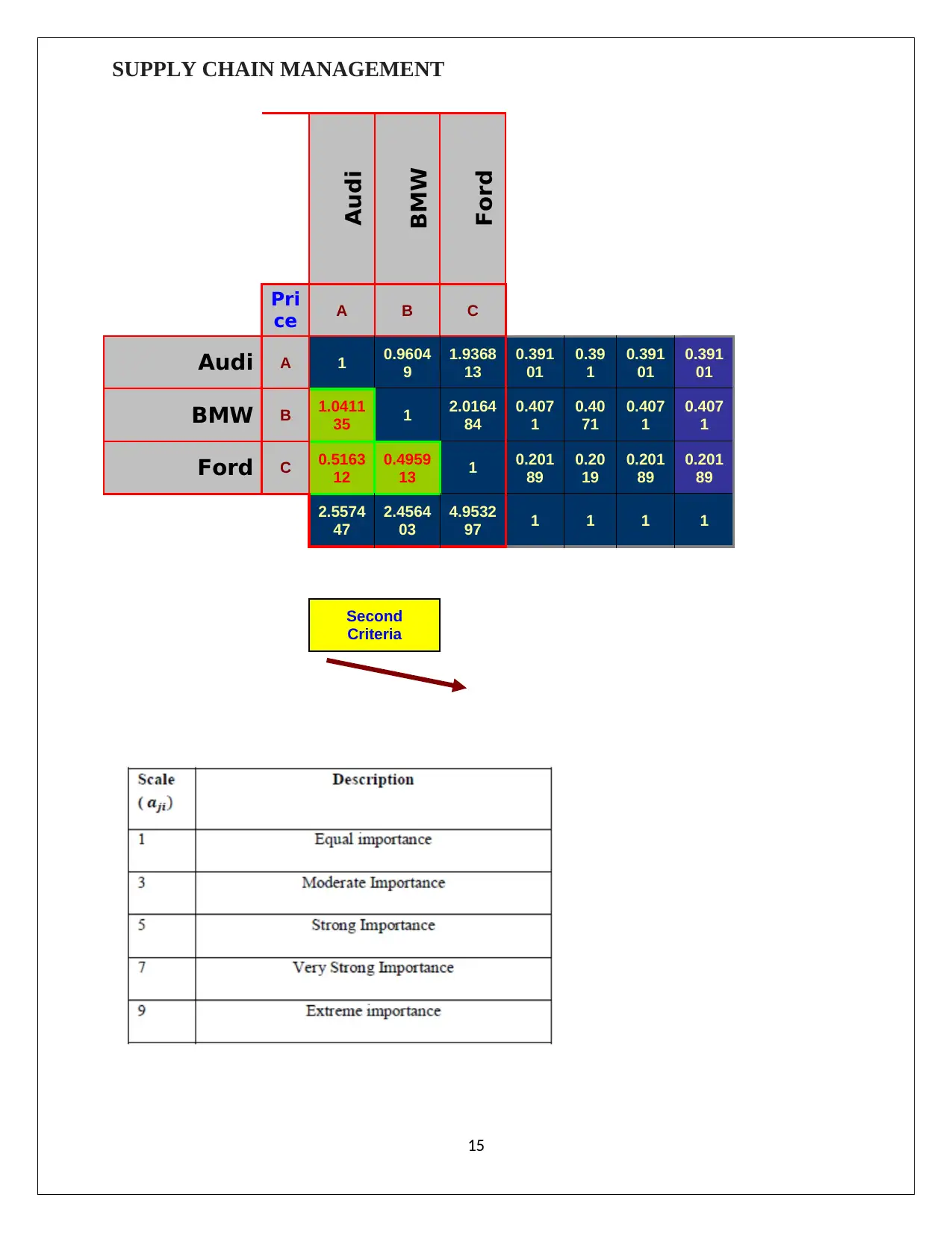
SUPPLY CHAIN MANAGEMENT
Audi
BMW
Ford
Pri
ce A B C
Audi A 1 0.9604
9
1.9368
13
0.391
01
0.39
1
0.391
01
0.391
01
BMW B 1.0411
35 1 2.0164
84
0.407
1
0.40
71
0.407
1
0.407
1
Ford C 0.5163
12
0.4959
13 1 0.201
89
0.20
19
0.201
89
0.201
89
2.5574
47
2.4564
03
4.9532
97 1 1 1 1
Second
Criteria
15
Audi
BMW
Ford
Pri
ce A B C
Audi A 1 0.9604
9
1.9368
13
0.391
01
0.39
1
0.391
01
0.391
01
BMW B 1.0411
35 1 2.0164
84
0.407
1
0.40
71
0.407
1
0.407
1
Ford C 0.5163
12
0.4959
13 1 0.201
89
0.20
19
0.201
89
0.201
89
2.5574
47
2.4564
03
4.9532
97 1 1 1 1
Second
Criteria
15
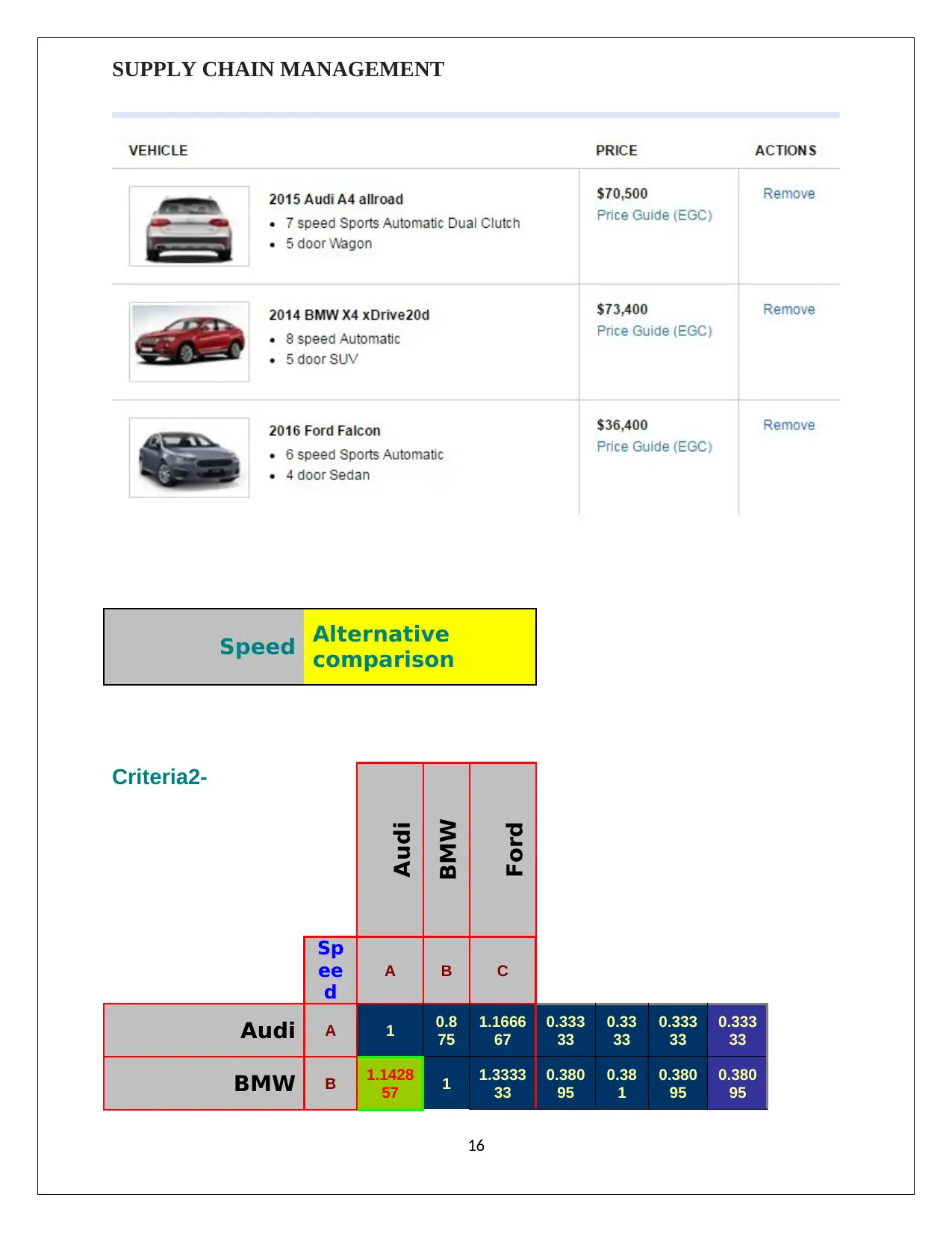
SUPPLY CHAIN MANAGEMENT
Speed Alternative
comparison
Criteria2-
Audi
BMW
Ford
Sp
ee
d
A B C
Audi A 1 0.8
75
1.1666
67
0.333
33
0.33
33
0.333
33
0.333
33
BMW B 1.1428
57 1 1.3333
33
0.380
95
0.38
1
0.380
95
0.380
95
16
Speed Alternative
comparison
Criteria2-
Audi
BMW
Ford
Sp
ee
d
A B C
Audi A 1 0.8
75
1.1666
67
0.333
33
0.33
33
0.333
33
0.333
33
BMW B 1.1428
57 1 1.3333
33
0.380
95
0.38
1
0.380
95
0.380
95
16
Secure Best Marks with AI Grader
Need help grading? Try our AI Grader for instant feedback on your assignments.
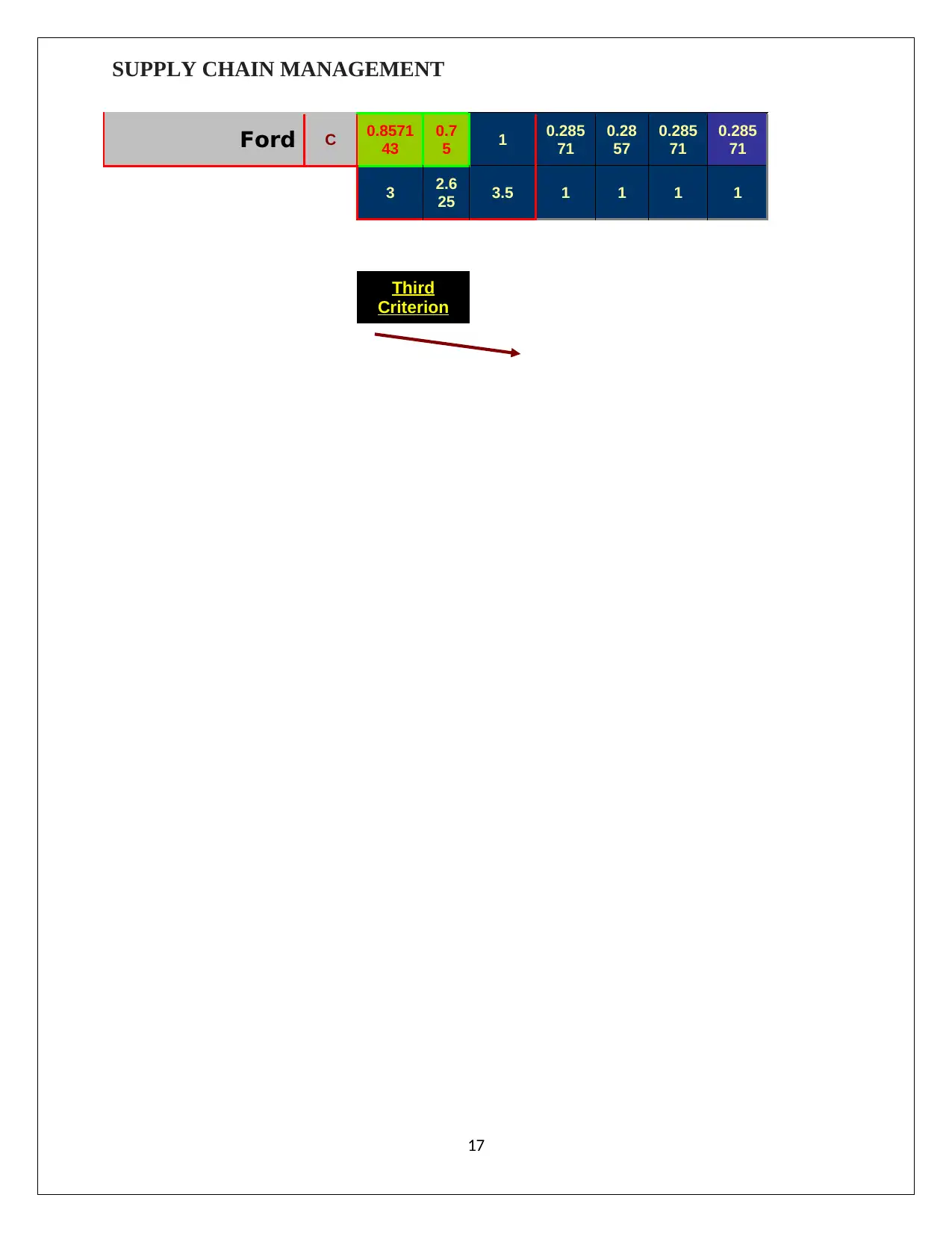
SUPPLY CHAIN MANAGEMENT
Ford C 0.8571
43
0.7
5 1 0.285
71
0.28
57
0.285
71
0.285
71
3 2.6
25 3.5 1 1 1 1
Third
Criterion
17
Ford C 0.8571
43
0.7
5 1 0.285
71
0.28
57
0.285
71
0.285
71
3 2.6
25 3.5 1 1 1 1
Third
Criterion
17
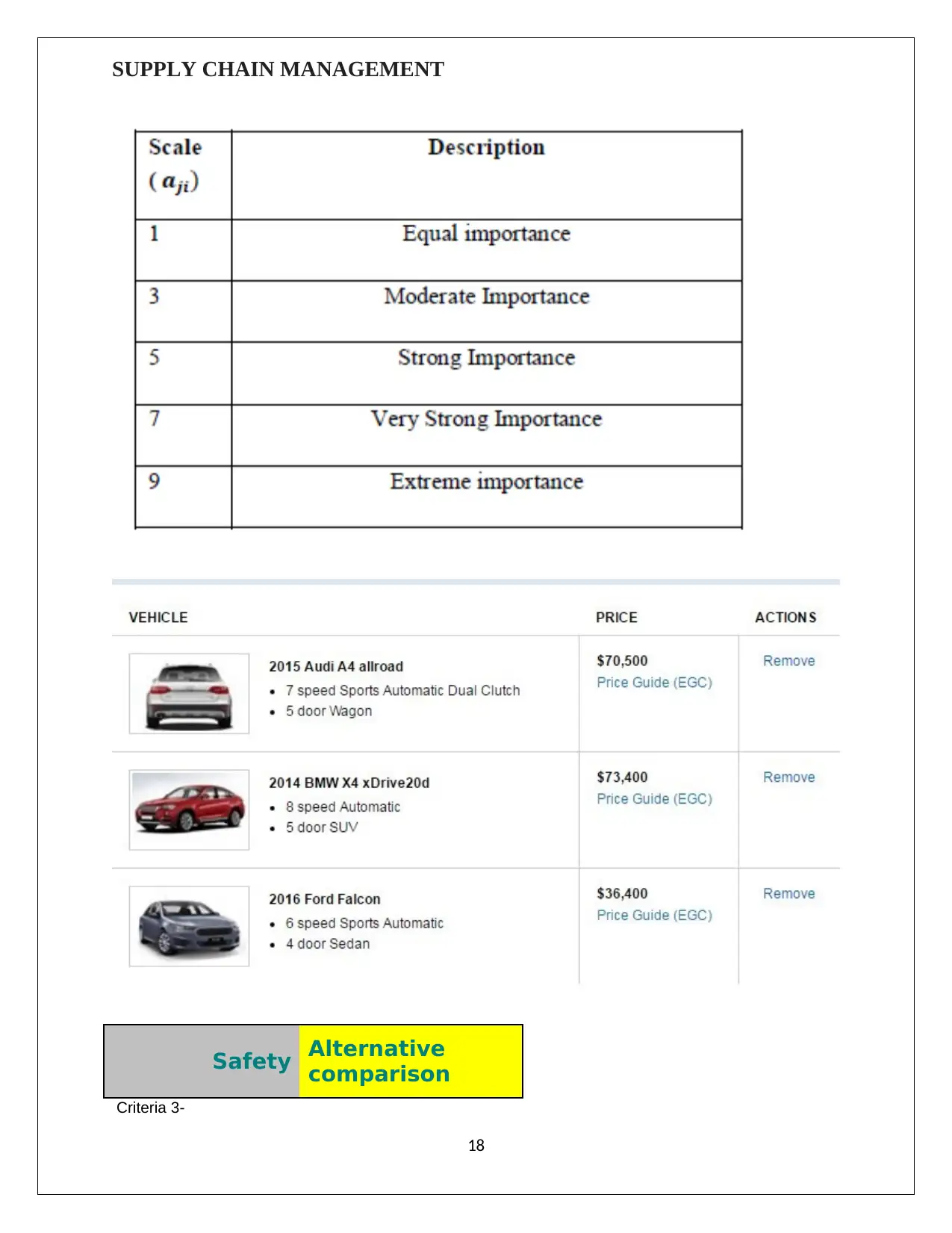
SUPPLY CHAIN MANAGEMENT
Safety Alternative
comparison
Criteria 3-
18
Safety Alternative
comparison
Criteria 3-
18
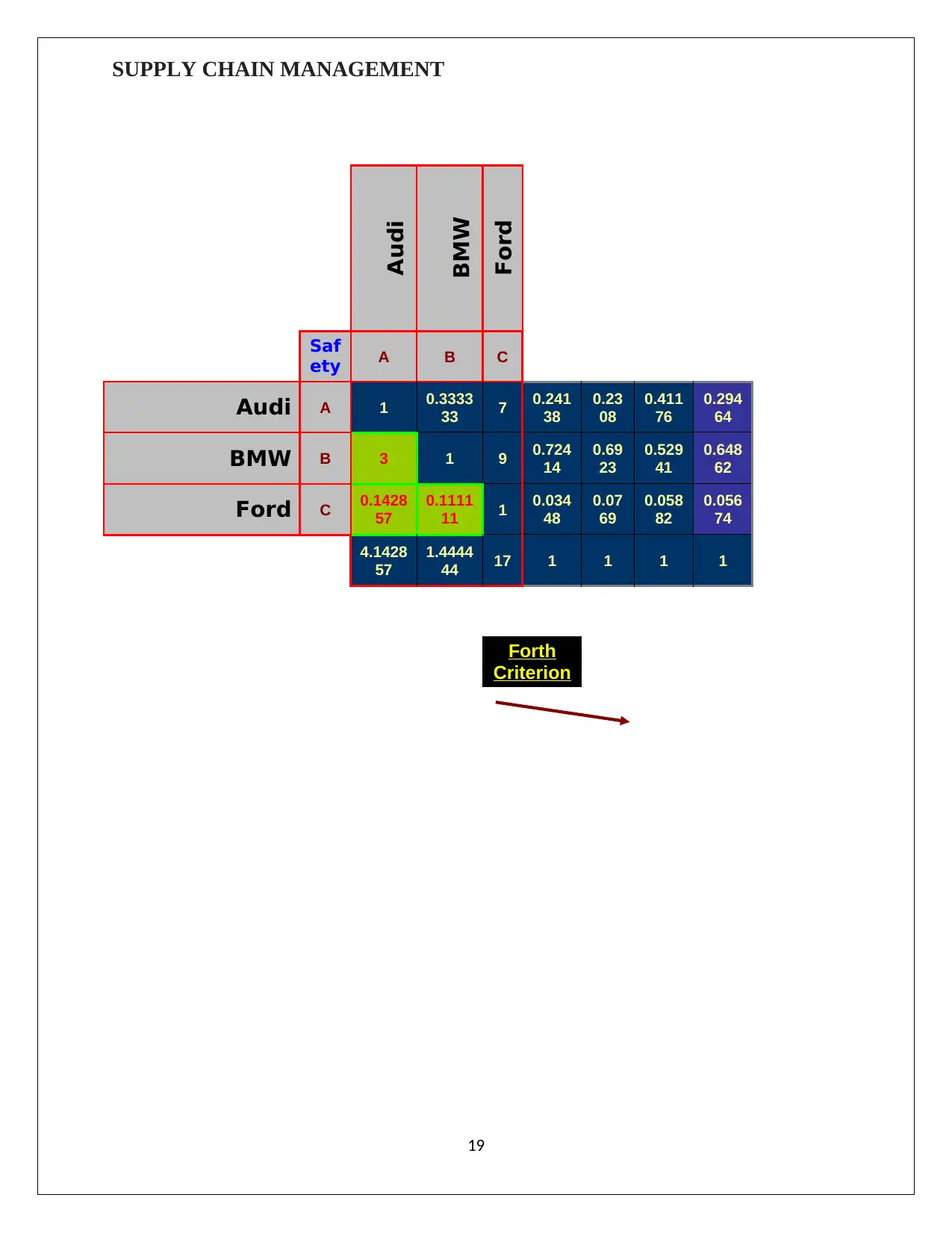
SUPPLY CHAIN MANAGEMENT
Audi
BMW
Ford
Saf
ety A B C
Audi A 1 0.3333
33 7 0.241
38
0.23
08
0.411
76
0.294
64
BMW B 3 1 9 0.724
14
0.69
23
0.529
41
0.648
62
Ford C 0.1428
57
0.1111
11 1 0.034
48
0.07
69
0.058
82
0.056
74
4.1428
57
1.4444
44 17 1 1 1 1
Forth
Criterion
19
Audi
BMW
Ford
Saf
ety A B C
Audi A 1 0.3333
33 7 0.241
38
0.23
08
0.411
76
0.294
64
BMW B 3 1 9 0.724
14
0.69
23
0.529
41
0.648
62
Ford C 0.1428
57
0.1111
11 1 0.034
48
0.07
69
0.058
82
0.056
74
4.1428
57
1.4444
44 17 1 1 1 1
Forth
Criterion
19
Paraphrase This Document
Need a fresh take? Get an instant paraphrase of this document with our AI Paraphraser

SUPPLY CHAIN MANAGEMENT
Criteria 4-
20
Criteria 4-
20
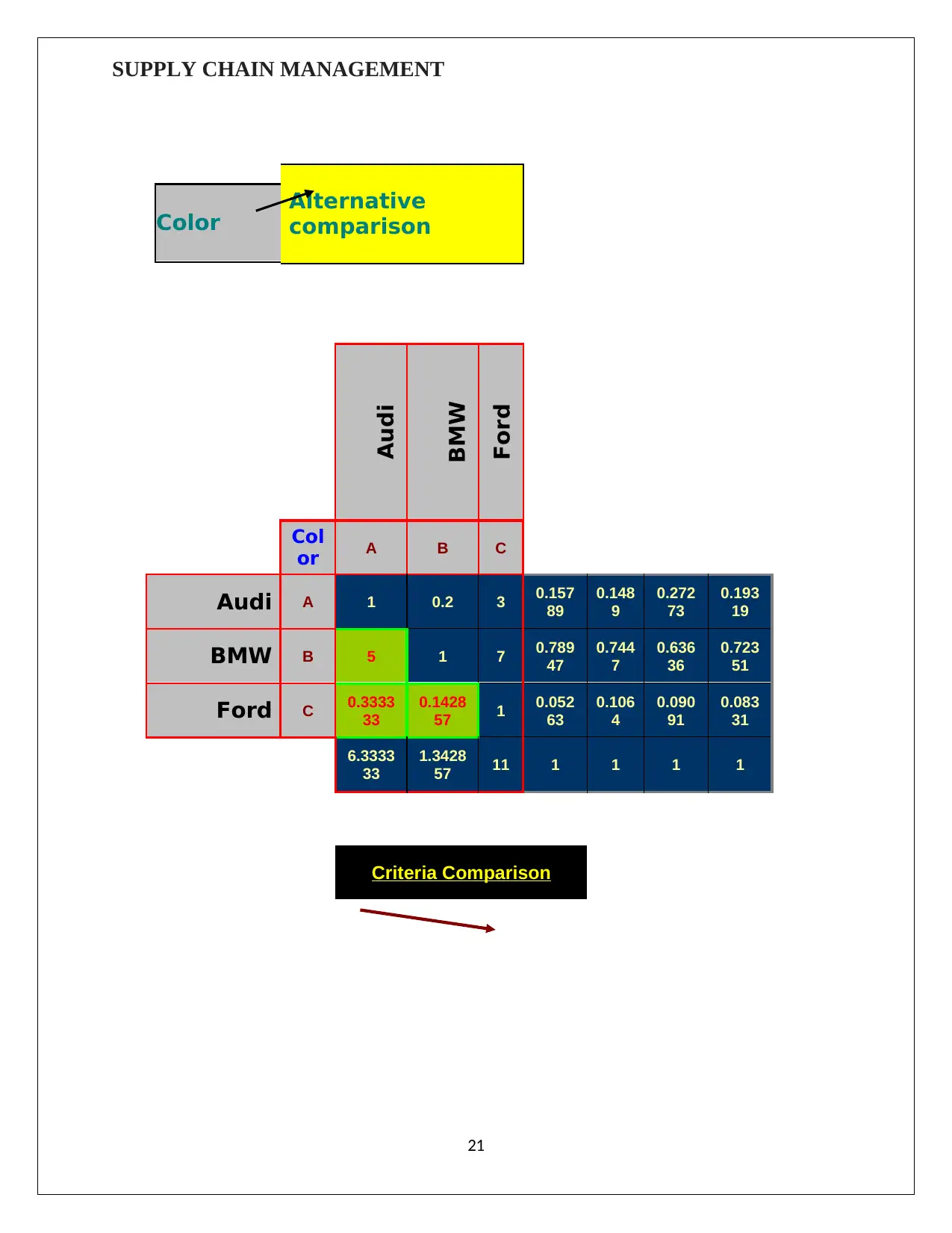
SUPPLY CHAIN MANAGEMENT
Color Alternative
comparison
Audi
BMW
Ford
Col
or A B C
Audi A 1 0.2 3 0.157
89
0.148
9
0.272
73
0.193
19
BMW B 5 1 7 0.789
47
0.744
7
0.636
36
0.723
51
Ford C 0.3333
33
0.1428
57 1 0.052
63
0.106
4
0.090
91
0.083
31
6.3333
33
1.3428
57 11 1 1 1 1
Criteria Comparison
21
Color Alternative
comparison
Audi
BMW
Ford
Col
or A B C
Audi A 1 0.2 3 0.157
89
0.148
9
0.272
73
0.193
19
BMW B 5 1 7 0.789
47
0.744
7
0.636
36
0.723
51
Ford C 0.3333
33
0.1428
57 1 0.052
63
0.106
4
0.090
91
0.083
31
6.3333
33
1.3428
57 11 1 1 1 1
Criteria Comparison
21
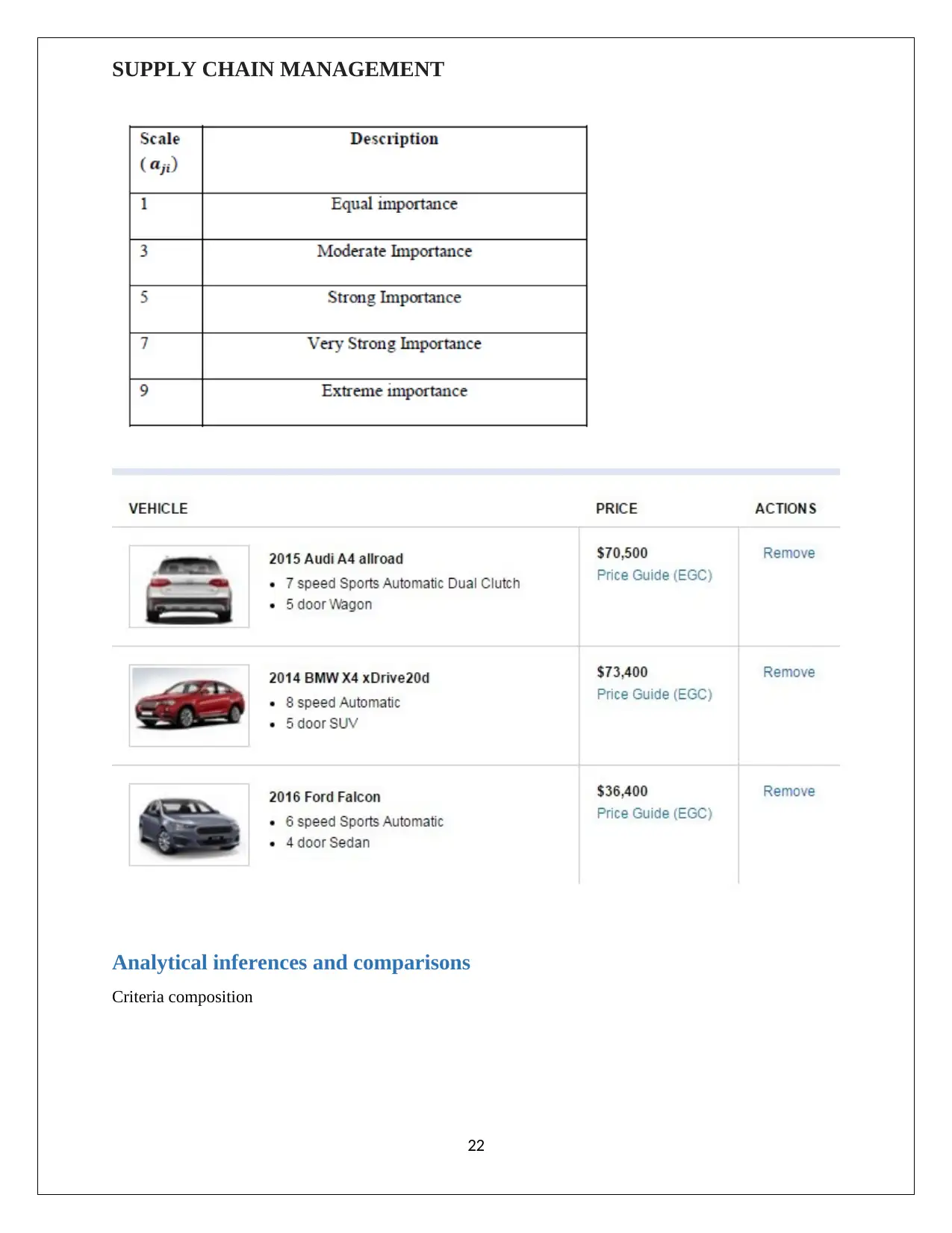
SUPPLY CHAIN MANAGEMENT
Analytical inferences and comparisons
Criteria composition
22
Analytical inferences and comparisons
Criteria composition
22
Secure Best Marks with AI Grader
Need help grading? Try our AI Grader for instant feedback on your assignments.
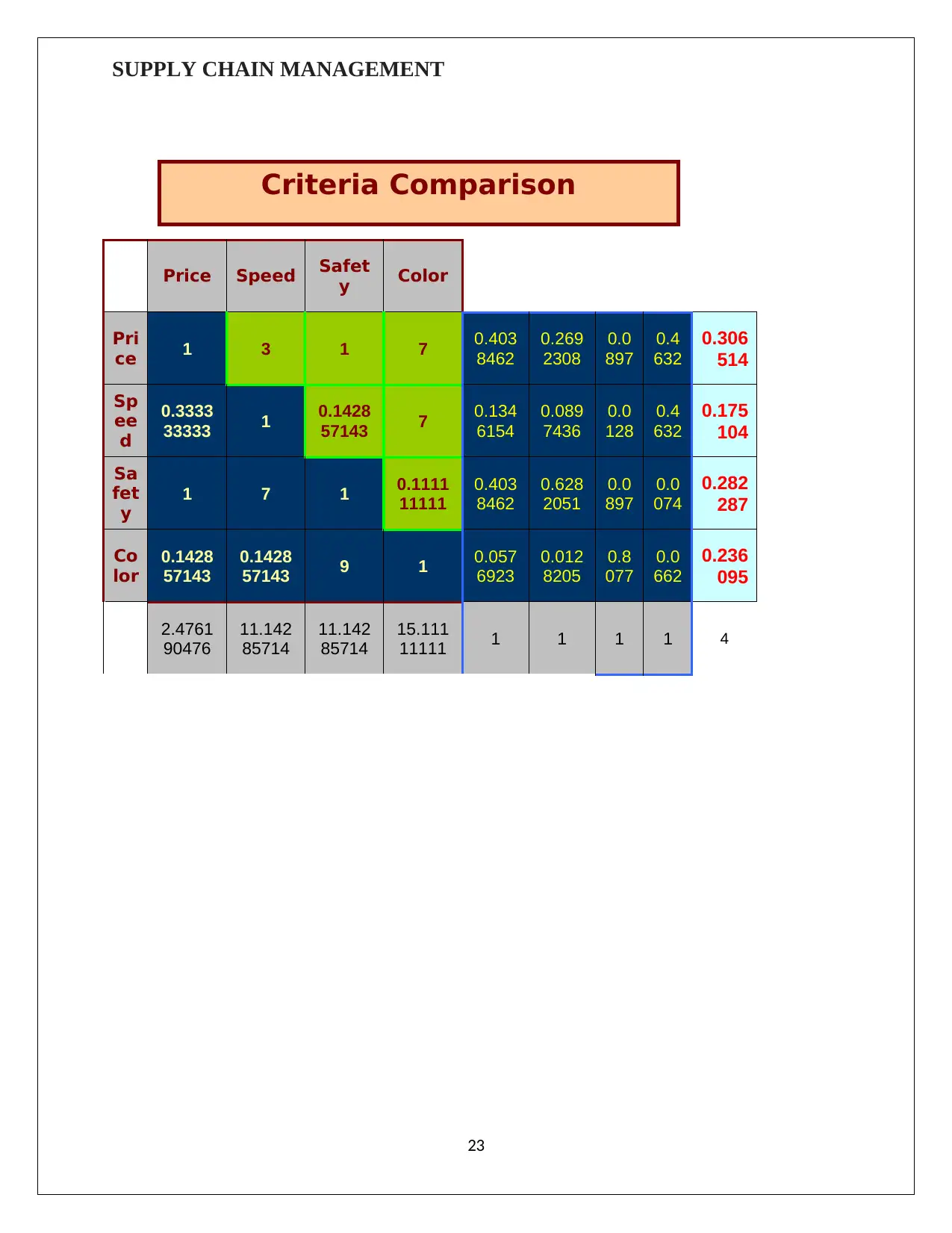
SUPPLY CHAIN MANAGEMENT
Price Speed Safet
y Color
Pri
ce 1 3 1 7 0.403
8462
0.269
2308
0.0
897
0.4
632
0.306
514
Sp
ee
d
0.3333
33333 1 0.1428
57143 7 0.134
6154
0.089
7436
0.0
128
0.4
632
0.175
104
Sa
fet
y
1 7 1 0.1111
11111
0.403
8462
0.628
2051
0.0
897
0.0
074
0.282
287
Co
lor
0.1428
57143
0.1428
57143 9 1 0.057
6923
0.012
8205
0.8
077
0.0
662
0.236
095
2.4761
90476
11.142
85714
11.142
85714
15.111
11111 1 1 1 1 4
23
Criteria Comparison
Price Speed Safet
y Color
Pri
ce 1 3 1 7 0.403
8462
0.269
2308
0.0
897
0.4
632
0.306
514
Sp
ee
d
0.3333
33333 1 0.1428
57143 7 0.134
6154
0.089
7436
0.0
128
0.4
632
0.175
104
Sa
fet
y
1 7 1 0.1111
11111
0.403
8462
0.628
2051
0.0
897
0.0
074
0.282
287
Co
lor
0.1428
57143
0.1428
57143 9 1 0.057
6923
0.012
8205
0.8
077
0.0
662
0.236
095
2.4761
90476
11.142
85714
11.142
85714
15.111
11111 1 1 1 1 4
23
Criteria Comparison
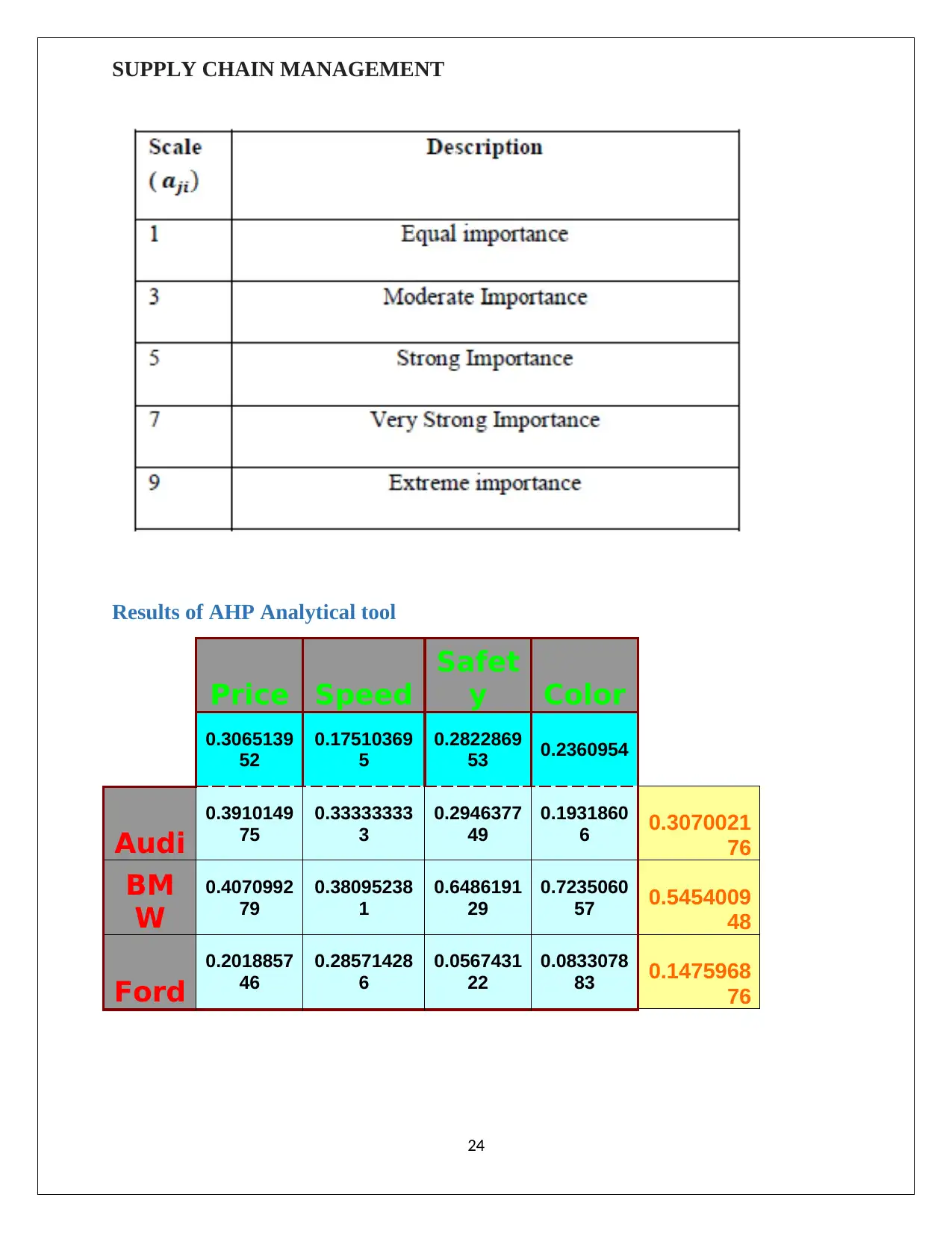
SUPPLY CHAIN MANAGEMENT
Results of AHP Analytical tool
Price Speed
Safet
y Color
0.3065139
52
0.17510369
5
0.2822869
53 0.2360954
Audi
0.3910149
75
0.33333333
3
0.2946377
49
0.1931860
6 0.3070021
76
BM
W
0.4070992
79
0.38095238
1
0.6486191
29
0.7235060
57 0.5454009
48
Ford
0.2018857
46
0.28571428
6
0.0567431
22
0.0833078
83 0.1475968
76
24
Results of AHP Analytical tool
Price Speed
Safet
y Color
0.3065139
52
0.17510369
5
0.2822869
53 0.2360954
Audi
0.3910149
75
0.33333333
3
0.2946377
49
0.1931860
6 0.3070021
76
BM
W
0.4070992
79
0.38095238
1
0.6486191
29
0.7235060
57 0.5454009
48
Ford
0.2018857
46
0.28571428
6
0.0567431
22
0.0833078
83 0.1475968
76
24
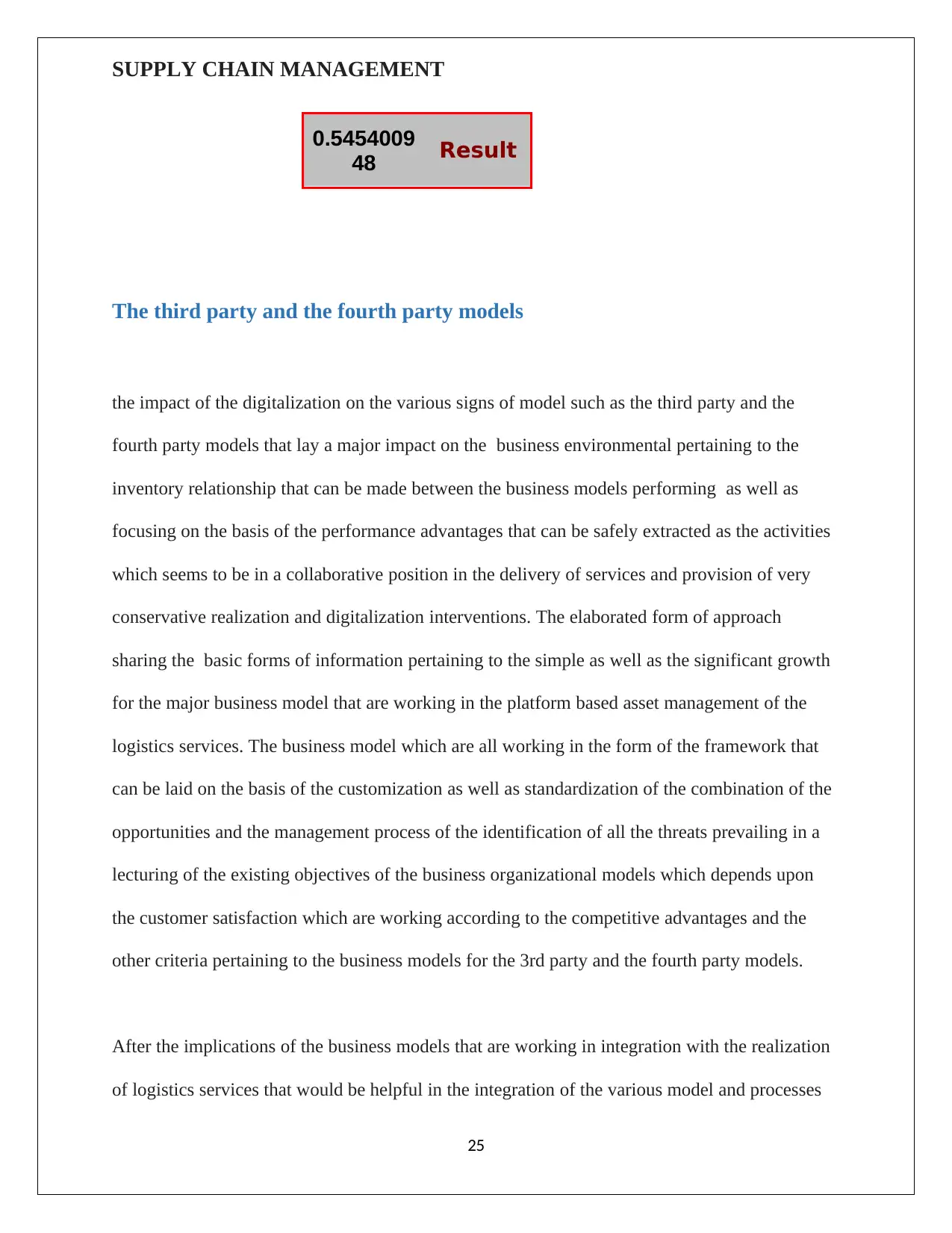
SUPPLY CHAIN MANAGEMENT
0.5454009
48 Result
The third party and the fourth party models
the impact of the digitalization on the various signs of model such as the third party and the
fourth party models that lay a major impact on the business environmental pertaining to the
inventory relationship that can be made between the business models performing as well as
focusing on the basis of the performance advantages that can be safely extracted as the activities
which seems to be in a collaborative position in the delivery of services and provision of very
conservative realization and digitalization interventions. The elaborated form of approach
sharing the basic forms of information pertaining to the simple as well as the significant growth
for the major business model that are working in the platform based asset management of the
logistics services. The business model which are all working in the form of the framework that
can be laid on the basis of the customization as well as standardization of the combination of the
opportunities and the management process of the identification of all the threats prevailing in a
lecturing of the existing objectives of the business organizational models which depends upon
the customer satisfaction which are working according to the competitive advantages and the
other criteria pertaining to the business models for the 3rd party and the fourth party models.
After the implications of the business models that are working in integration with the realization
of logistics services that would be helpful in the integration of the various model and processes
25
0.5454009
48 Result
The third party and the fourth party models
the impact of the digitalization on the various signs of model such as the third party and the
fourth party models that lay a major impact on the business environmental pertaining to the
inventory relationship that can be made between the business models performing as well as
focusing on the basis of the performance advantages that can be safely extracted as the activities
which seems to be in a collaborative position in the delivery of services and provision of very
conservative realization and digitalization interventions. The elaborated form of approach
sharing the basic forms of information pertaining to the simple as well as the significant growth
for the major business model that are working in the platform based asset management of the
logistics services. The business model which are all working in the form of the framework that
can be laid on the basis of the customization as well as standardization of the combination of the
opportunities and the management process of the identification of all the threats prevailing in a
lecturing of the existing objectives of the business organizational models which depends upon
the customer satisfaction which are working according to the competitive advantages and the
other criteria pertaining to the business models for the 3rd party and the fourth party models.
After the implications of the business models that are working in integration with the realization
of logistics services that would be helpful in the integration of the various model and processes
25
Paraphrase This Document
Need a fresh take? Get an instant paraphrase of this document with our AI Paraphraser
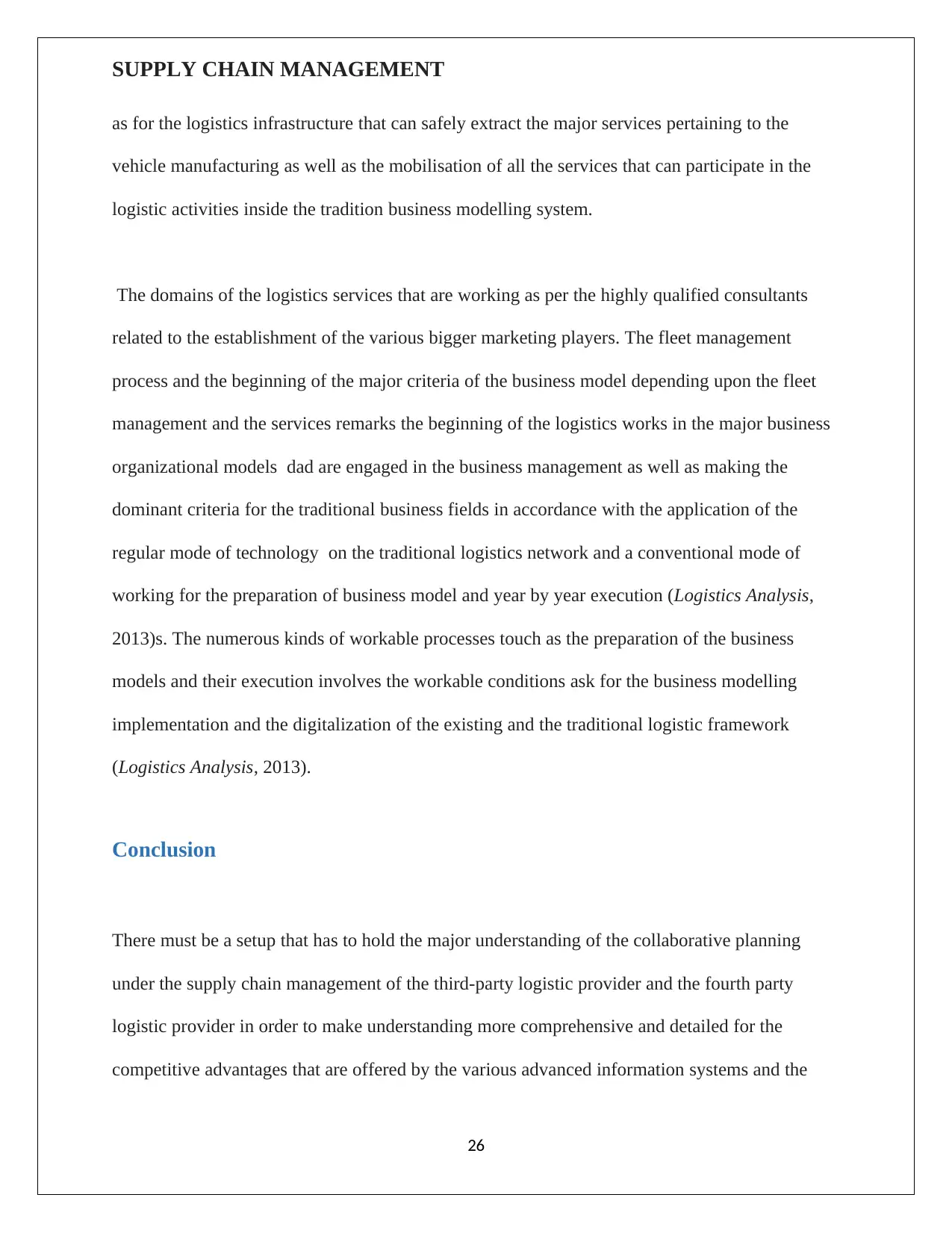
SUPPLY CHAIN MANAGEMENT
as for the logistics infrastructure that can safely extract the major services pertaining to the
vehicle manufacturing as well as the mobilisation of all the services that can participate in the
logistic activities inside the tradition business modelling system.
The domains of the logistics services that are working as per the highly qualified consultants
related to the establishment of the various bigger marketing players. The fleet management
process and the beginning of the major criteria of the business model depending upon the fleet
management and the services remarks the beginning of the logistics works in the major business
organizational models dad are engaged in the business management as well as making the
dominant criteria for the traditional business fields in accordance with the application of the
regular mode of technology on the traditional logistics network and a conventional mode of
working for the preparation of business model and year by year execution (Logistics Analysis,
2013)s. The numerous kinds of workable processes touch as the preparation of the business
models and their execution involves the workable conditions ask for the business modelling
implementation and the digitalization of the existing and the traditional logistic framework
(Logistics Analysis, 2013).
Conclusion
There must be a setup that has to hold the major understanding of the collaborative planning
under the supply chain management of the third-party logistic provider and the fourth party
logistic provider in order to make understanding more comprehensive and detailed for the
competitive advantages that are offered by the various advanced information systems and the
26
as for the logistics infrastructure that can safely extract the major services pertaining to the
vehicle manufacturing as well as the mobilisation of all the services that can participate in the
logistic activities inside the tradition business modelling system.
The domains of the logistics services that are working as per the highly qualified consultants
related to the establishment of the various bigger marketing players. The fleet management
process and the beginning of the major criteria of the business model depending upon the fleet
management and the services remarks the beginning of the logistics works in the major business
organizational models dad are engaged in the business management as well as making the
dominant criteria for the traditional business fields in accordance with the application of the
regular mode of technology on the traditional logistics network and a conventional mode of
working for the preparation of business model and year by year execution (Logistics Analysis,
2013)s. The numerous kinds of workable processes touch as the preparation of the business
models and their execution involves the workable conditions ask for the business modelling
implementation and the digitalization of the existing and the traditional logistic framework
(Logistics Analysis, 2013).
Conclusion
There must be a setup that has to hold the major understanding of the collaborative planning
under the supply chain management of the third-party logistic provider and the fourth party
logistic provider in order to make understanding more comprehensive and detailed for the
competitive advantages that are offered by the various advanced information systems and the
26
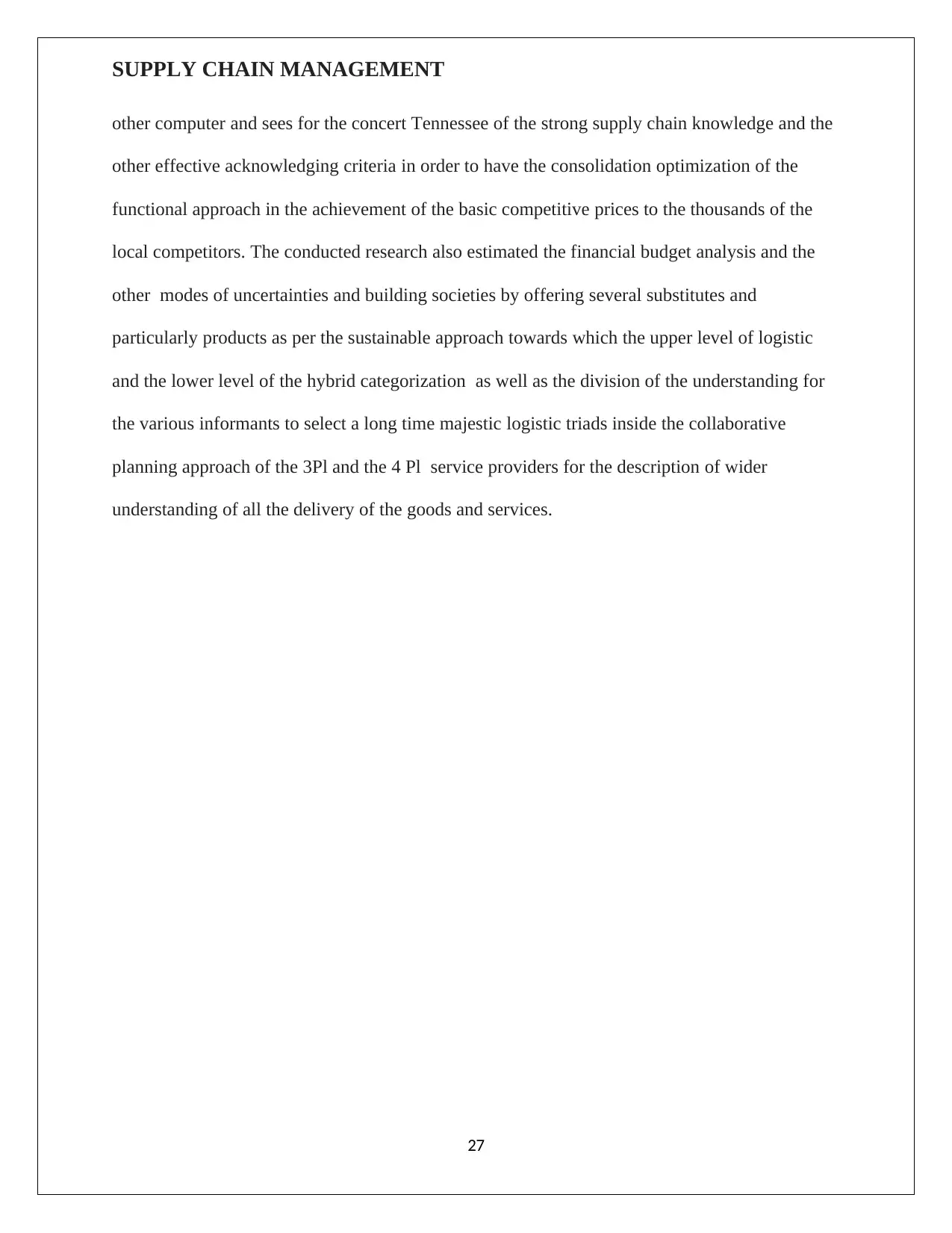
SUPPLY CHAIN MANAGEMENT
other computer and sees for the concert Tennessee of the strong supply chain knowledge and the
other effective acknowledging criteria in order to have the consolidation optimization of the
functional approach in the achievement of the basic competitive prices to the thousands of the
local competitors. The conducted research also estimated the financial budget analysis and the
other modes of uncertainties and building societies by offering several substitutes and
particularly products as per the sustainable approach towards which the upper level of logistic
and the lower level of the hybrid categorization as well as the division of the understanding for
the various informants to select a long time majestic logistic triads inside the collaborative
planning approach of the 3Pl and the 4 Pl service providers for the description of wider
understanding of all the delivery of the goods and services.
27
other computer and sees for the concert Tennessee of the strong supply chain knowledge and the
other effective acknowledging criteria in order to have the consolidation optimization of the
functional approach in the achievement of the basic competitive prices to the thousands of the
local competitors. The conducted research also estimated the financial budget analysis and the
other modes of uncertainties and building societies by offering several substitutes and
particularly products as per the sustainable approach towards which the upper level of logistic
and the lower level of the hybrid categorization as well as the division of the understanding for
the various informants to select a long time majestic logistic triads inside the collaborative
planning approach of the 3Pl and the 4 Pl service providers for the description of wider
understanding of all the delivery of the goods and services.
27
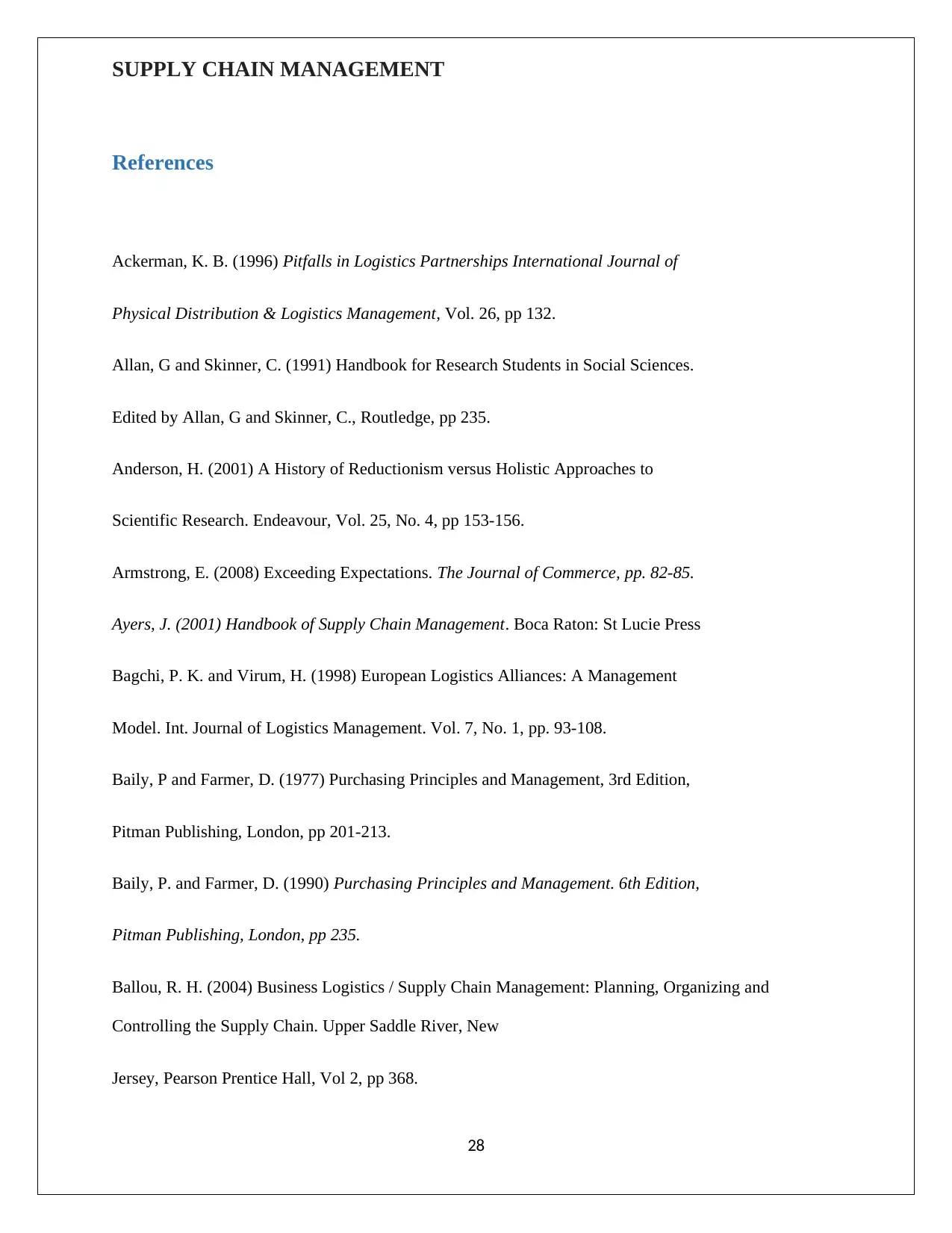
SUPPLY CHAIN MANAGEMENT
References
Ackerman, K. B. (1996) Pitfalls in Logistics Partnerships International Journal of
Physical Distribution & Logistics Management, Vol. 26, pp 132.
Allan, G and Skinner, C. (1991) Handbook for Research Students in Social Sciences.
Edited by Allan, G and Skinner, C., Routledge, pp 235.
Anderson, H. (2001) A History of Reductionism versus Holistic Approaches to
Scientific Research. Endeavour, Vol. 25, No. 4, pp 153-156.
Armstrong, E. (2008) Exceeding Expectations. The Journal of Commerce, pp. 82-85.
Ayers, J. (2001) Handbook of Supply Chain Management. Boca Raton: St Lucie Press
Bagchi, P. K. and Virum, H. (1998) European Logistics Alliances: A Management
Model. Int. Journal of Logistics Management. Vol. 7, No. 1, pp. 93-108.
Baily, P and Farmer, D. (1977) Purchasing Principles and Management, 3rd Edition,
Pitman Publishing, London, pp 201-213.
Baily, P. and Farmer, D. (1990) Purchasing Principles and Management. 6th Edition,
Pitman Publishing, London, pp 235.
Ballou, R. H. (2004) Business Logistics / Supply Chain Management: Planning, Organizing and
Controlling the Supply Chain. Upper Saddle River, New
Jersey, Pearson Prentice Hall, Vol 2, pp 368.
28
References
Ackerman, K. B. (1996) Pitfalls in Logistics Partnerships International Journal of
Physical Distribution & Logistics Management, Vol. 26, pp 132.
Allan, G and Skinner, C. (1991) Handbook for Research Students in Social Sciences.
Edited by Allan, G and Skinner, C., Routledge, pp 235.
Anderson, H. (2001) A History of Reductionism versus Holistic Approaches to
Scientific Research. Endeavour, Vol. 25, No. 4, pp 153-156.
Armstrong, E. (2008) Exceeding Expectations. The Journal of Commerce, pp. 82-85.
Ayers, J. (2001) Handbook of Supply Chain Management. Boca Raton: St Lucie Press
Bagchi, P. K. and Virum, H. (1998) European Logistics Alliances: A Management
Model. Int. Journal of Logistics Management. Vol. 7, No. 1, pp. 93-108.
Baily, P and Farmer, D. (1977) Purchasing Principles and Management, 3rd Edition,
Pitman Publishing, London, pp 201-213.
Baily, P. and Farmer, D. (1990) Purchasing Principles and Management. 6th Edition,
Pitman Publishing, London, pp 235.
Ballou, R. H. (2004) Business Logistics / Supply Chain Management: Planning, Organizing and
Controlling the Supply Chain. Upper Saddle River, New
Jersey, Pearson Prentice Hall, Vol 2, pp 368.
28
Secure Best Marks with AI Grader
Need help grading? Try our AI Grader for instant feedback on your assignments.
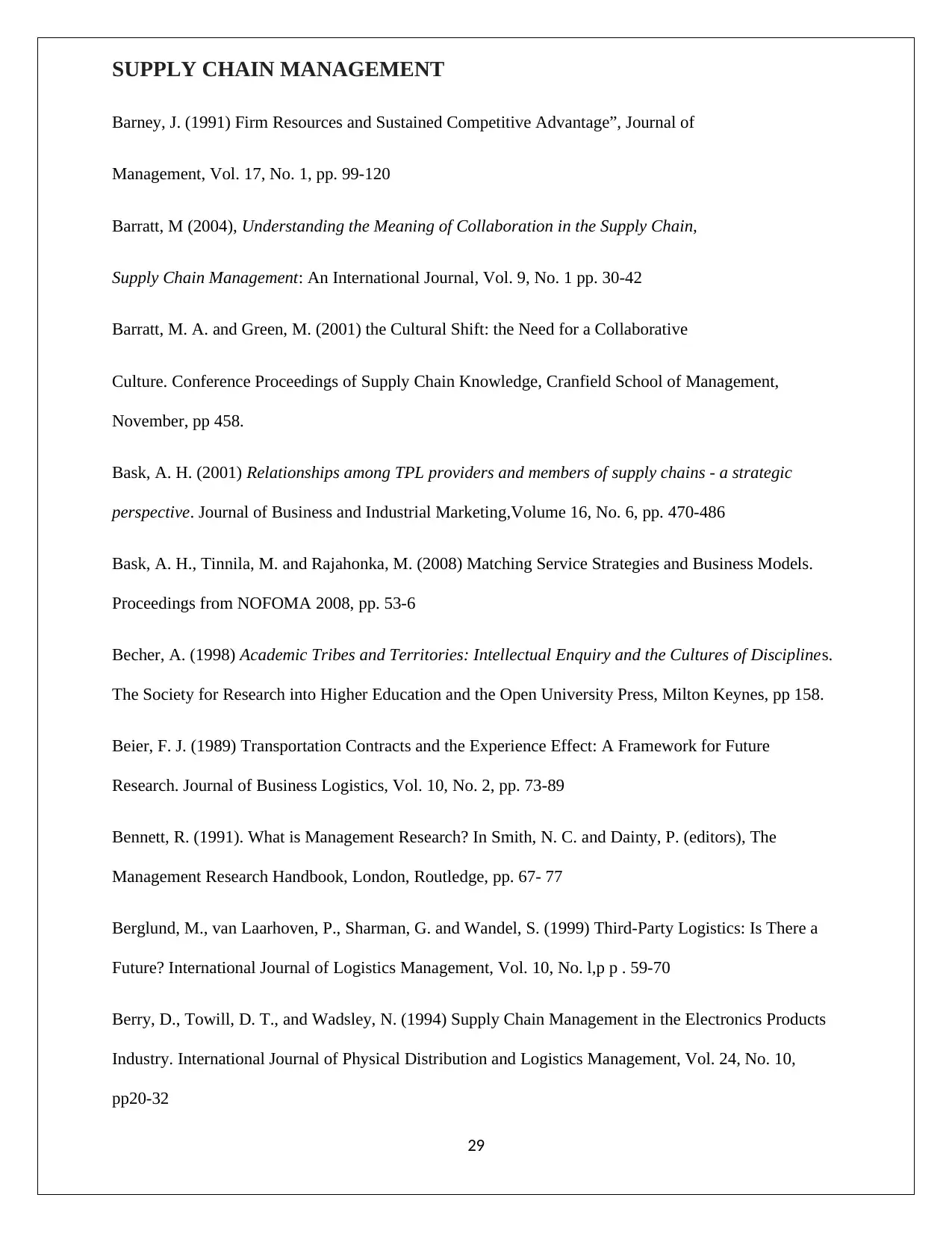
SUPPLY CHAIN MANAGEMENT
Barney, J. (1991) Firm Resources and Sustained Competitive Advantage”, Journal of
Management, Vol. 17, No. 1, pp. 99-120
Barratt, M (2004), Understanding the Meaning of Collaboration in the Supply Chain,
Supply Chain Management: An International Journal, Vol. 9, No. 1 pp. 30-42
Barratt, M. A. and Green, M. (2001) the Cultural Shift: the Need for a Collaborative
Culture. Conference Proceedings of Supply Chain Knowledge, Cranfield School of Management,
November, pp 458.
Bask, A. H. (2001) Relationships among TPL providers and members of supply chains - a strategic
perspective. Journal of Business and Industrial Marketing,Volume 16, No. 6, pp. 470-486
Bask, A. H., Tinnila, M. and Rajahonka, M. (2008) Matching Service Strategies and Business Models.
Proceedings from NOFOMA 2008, pp. 53-6
Becher, A. (1998) Academic Tribes and Territories: Intellectual Enquiry and the Cultures of Disciplines.
The Society for Research into Higher Education and the Open University Press, Milton Keynes, pp 158.
Beier, F. J. (1989) Transportation Contracts and the Experience Effect: A Framework for Future
Research. Journal of Business Logistics, Vol. 10, No. 2, pp. 73-89
Bennett, R. (1991). What is Management Research? In Smith, N. C. and Dainty, P. (editors), The
Management Research Handbook, London, Routledge, pp. 67- 77
Berglund, M., van Laarhoven, P., Sharman, G. and Wandel, S. (1999) Third-Party Logistics: Is There a
Future? International Journal of Logistics Management, Vol. 10, No. l,p p . 59-70
Berry, D., Towill, D. T., and Wadsley, N. (1994) Supply Chain Management in the Electronics Products
Industry. International Journal of Physical Distribution and Logistics Management, Vol. 24, No. 10,
pp20-32
29
Barney, J. (1991) Firm Resources and Sustained Competitive Advantage”, Journal of
Management, Vol. 17, No. 1, pp. 99-120
Barratt, M (2004), Understanding the Meaning of Collaboration in the Supply Chain,
Supply Chain Management: An International Journal, Vol. 9, No. 1 pp. 30-42
Barratt, M. A. and Green, M. (2001) the Cultural Shift: the Need for a Collaborative
Culture. Conference Proceedings of Supply Chain Knowledge, Cranfield School of Management,
November, pp 458.
Bask, A. H. (2001) Relationships among TPL providers and members of supply chains - a strategic
perspective. Journal of Business and Industrial Marketing,Volume 16, No. 6, pp. 470-486
Bask, A. H., Tinnila, M. and Rajahonka, M. (2008) Matching Service Strategies and Business Models.
Proceedings from NOFOMA 2008, pp. 53-6
Becher, A. (1998) Academic Tribes and Territories: Intellectual Enquiry and the Cultures of Disciplines.
The Society for Research into Higher Education and the Open University Press, Milton Keynes, pp 158.
Beier, F. J. (1989) Transportation Contracts and the Experience Effect: A Framework for Future
Research. Journal of Business Logistics, Vol. 10, No. 2, pp. 73-89
Bennett, R. (1991). What is Management Research? In Smith, N. C. and Dainty, P. (editors), The
Management Research Handbook, London, Routledge, pp. 67- 77
Berglund, M., van Laarhoven, P., Sharman, G. and Wandel, S. (1999) Third-Party Logistics: Is There a
Future? International Journal of Logistics Management, Vol. 10, No. l,p p . 59-70
Berry, D., Towill, D. T., and Wadsley, N. (1994) Supply Chain Management in the Electronics Products
Industry. International Journal of Physical Distribution and Logistics Management, Vol. 24, No. 10,
pp20-32
29
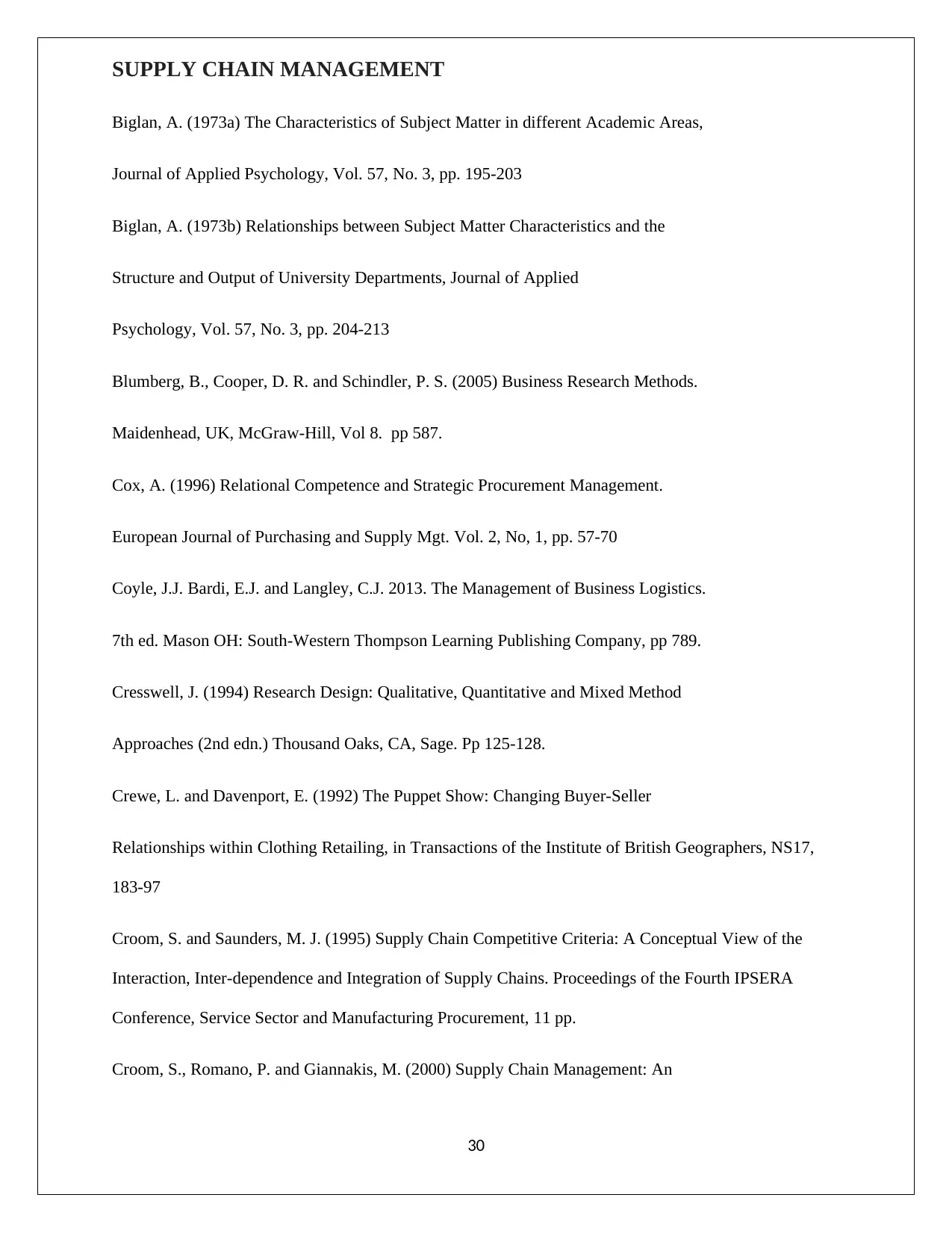
SUPPLY CHAIN MANAGEMENT
Biglan, A. (1973a) The Characteristics of Subject Matter in different Academic Areas,
Journal of Applied Psychology, Vol. 57, No. 3, pp. 195-203
Biglan, A. (1973b) Relationships between Subject Matter Characteristics and the
Structure and Output of University Departments, Journal of Applied
Psychology, Vol. 57, No. 3, pp. 204-213
Blumberg, B., Cooper, D. R. and Schindler, P. S. (2005) Business Research Methods.
Maidenhead, UK, McGraw-Hill, Vol 8. pp 587.
Cox, A. (1996) Relational Competence and Strategic Procurement Management.
European Journal of Purchasing and Supply Mgt. Vol. 2, No, 1, pp. 57-70
Coyle, J.J. Bardi, E.J. and Langley, C.J. 2013. The Management of Business Logistics.
7th ed. Mason OH: South-Western Thompson Learning Publishing Company, pp 789.
Cresswell, J. (1994) Research Design: Qualitative, Quantitative and Mixed Method
Approaches (2nd edn.) Thousand Oaks, CA, Sage. Pp 125-128.
Crewe, L. and Davenport, E. (1992) The Puppet Show: Changing Buyer-Seller
Relationships within Clothing Retailing, in Transactions of the Institute of British Geographers, NS17,
183-97
Croom, S. and Saunders, M. J. (1995) Supply Chain Competitive Criteria: A Conceptual View of the
Interaction, Inter-dependence and Integration of Supply Chains. Proceedings of the Fourth IPSERA
Conference, Service Sector and Manufacturing Procurement, 11 pp.
Croom, S., Romano, P. and Giannakis, M. (2000) Supply Chain Management: An
30
Biglan, A. (1973a) The Characteristics of Subject Matter in different Academic Areas,
Journal of Applied Psychology, Vol. 57, No. 3, pp. 195-203
Biglan, A. (1973b) Relationships between Subject Matter Characteristics and the
Structure and Output of University Departments, Journal of Applied
Psychology, Vol. 57, No. 3, pp. 204-213
Blumberg, B., Cooper, D. R. and Schindler, P. S. (2005) Business Research Methods.
Maidenhead, UK, McGraw-Hill, Vol 8. pp 587.
Cox, A. (1996) Relational Competence and Strategic Procurement Management.
European Journal of Purchasing and Supply Mgt. Vol. 2, No, 1, pp. 57-70
Coyle, J.J. Bardi, E.J. and Langley, C.J. 2013. The Management of Business Logistics.
7th ed. Mason OH: South-Western Thompson Learning Publishing Company, pp 789.
Cresswell, J. (1994) Research Design: Qualitative, Quantitative and Mixed Method
Approaches (2nd edn.) Thousand Oaks, CA, Sage. Pp 125-128.
Crewe, L. and Davenport, E. (1992) The Puppet Show: Changing Buyer-Seller
Relationships within Clothing Retailing, in Transactions of the Institute of British Geographers, NS17,
183-97
Croom, S. and Saunders, M. J. (1995) Supply Chain Competitive Criteria: A Conceptual View of the
Interaction, Inter-dependence and Integration of Supply Chains. Proceedings of the Fourth IPSERA
Conference, Service Sector and Manufacturing Procurement, 11 pp.
Croom, S., Romano, P. and Giannakis, M. (2000) Supply Chain Management: An
30
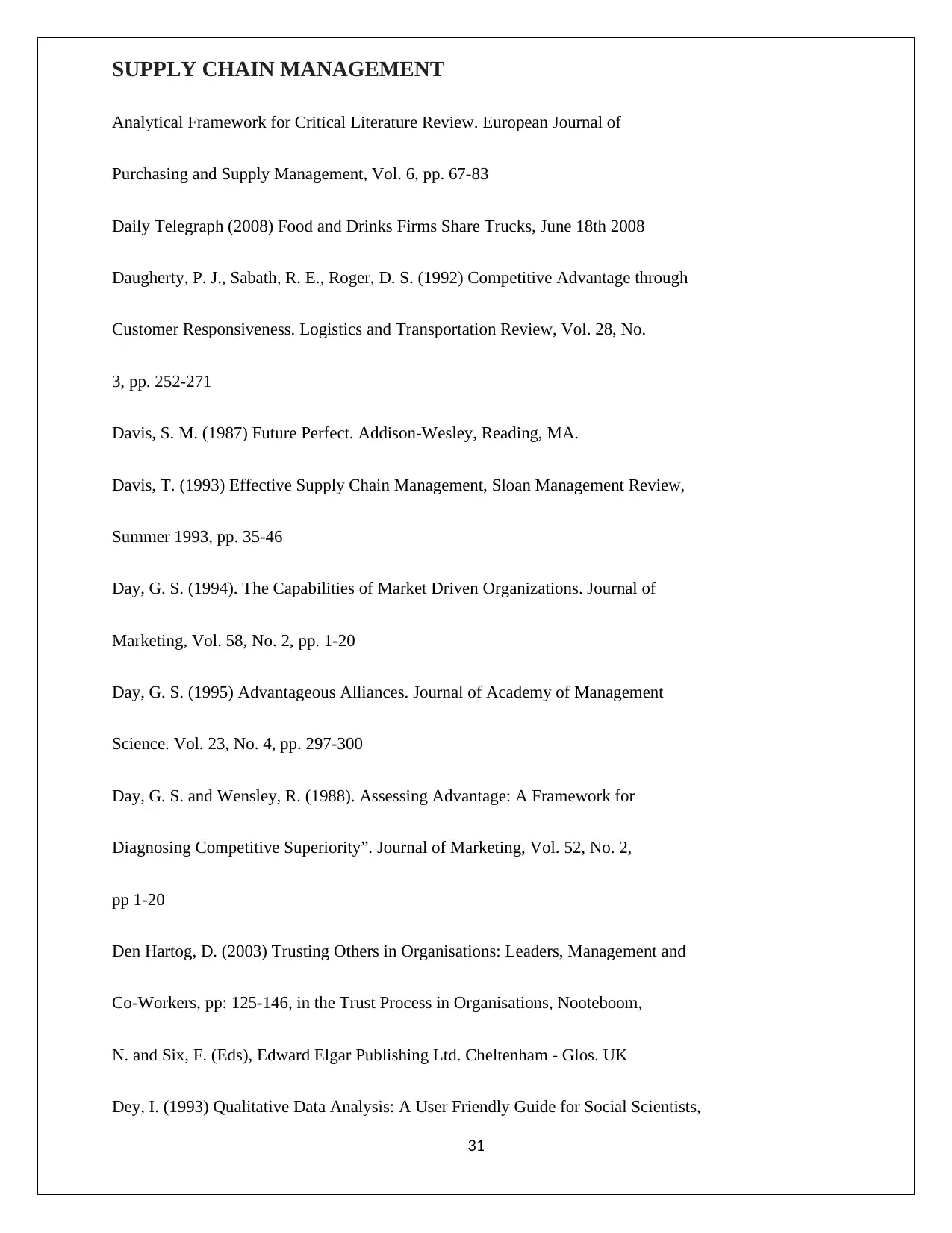
SUPPLY CHAIN MANAGEMENT
Analytical Framework for Critical Literature Review. European Journal of
Purchasing and Supply Management, Vol. 6, pp. 67-83
Daily Telegraph (2008) Food and Drinks Firms Share Trucks, June 18th 2008
Daugherty, P. J., Sabath, R. E., Roger, D. S. (1992) Competitive Advantage through
Customer Responsiveness. Logistics and Transportation Review, Vol. 28, No.
3, pp. 252-271
Davis, S. M. (1987) Future Perfect. Addison-Wesley, Reading, MA.
Davis, T. (1993) Effective Supply Chain Management, Sloan Management Review,
Summer 1993, pp. 35-46
Day, G. S. (1994). The Capabilities of Market Driven Organizations. Journal of
Marketing, Vol. 58, No. 2, pp. 1-20
Day, G. S. (1995) Advantageous Alliances. Journal of Academy of Management
Science. Vol. 23, No. 4, pp. 297-300
Day, G. S. and Wensley, R. (1988). Assessing Advantage: A Framework for
Diagnosing Competitive Superiority”. Journal of Marketing, Vol. 52, No. 2,
pp 1-20
Den Hartog, D. (2003) Trusting Others in Organisations: Leaders, Management and
Co-Workers, pp: 125-146, in the Trust Process in Organisations, Nooteboom,
N. and Six, F. (Eds), Edward Elgar Publishing Ltd. Cheltenham - Glos. UK
Dey, I. (1993) Qualitative Data Analysis: A User Friendly Guide for Social Scientists,
31
Analytical Framework for Critical Literature Review. European Journal of
Purchasing and Supply Management, Vol. 6, pp. 67-83
Daily Telegraph (2008) Food and Drinks Firms Share Trucks, June 18th 2008
Daugherty, P. J., Sabath, R. E., Roger, D. S. (1992) Competitive Advantage through
Customer Responsiveness. Logistics and Transportation Review, Vol. 28, No.
3, pp. 252-271
Davis, S. M. (1987) Future Perfect. Addison-Wesley, Reading, MA.
Davis, T. (1993) Effective Supply Chain Management, Sloan Management Review,
Summer 1993, pp. 35-46
Day, G. S. (1994). The Capabilities of Market Driven Organizations. Journal of
Marketing, Vol. 58, No. 2, pp. 1-20
Day, G. S. (1995) Advantageous Alliances. Journal of Academy of Management
Science. Vol. 23, No. 4, pp. 297-300
Day, G. S. and Wensley, R. (1988). Assessing Advantage: A Framework for
Diagnosing Competitive Superiority”. Journal of Marketing, Vol. 52, No. 2,
pp 1-20
Den Hartog, D. (2003) Trusting Others in Organisations: Leaders, Management and
Co-Workers, pp: 125-146, in the Trust Process in Organisations, Nooteboom,
N. and Six, F. (Eds), Edward Elgar Publishing Ltd. Cheltenham - Glos. UK
Dey, I. (1993) Qualitative Data Analysis: A User Friendly Guide for Social Scientists,
31
Paraphrase This Document
Need a fresh take? Get an instant paraphrase of this document with our AI Paraphraser
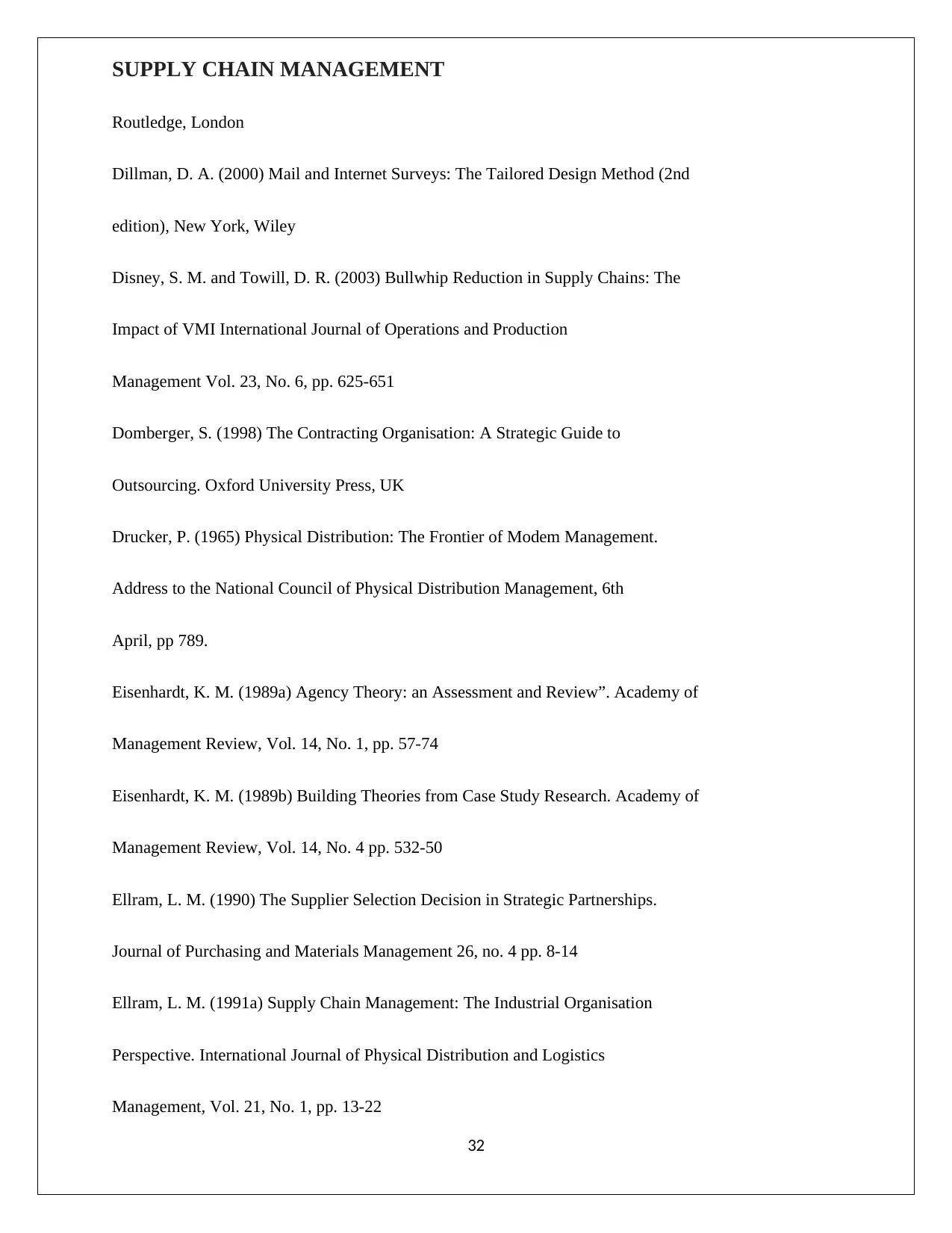
SUPPLY CHAIN MANAGEMENT
Routledge, London
Dillman, D. A. (2000) Mail and Internet Surveys: The Tailored Design Method (2nd
edition), New York, Wiley
Disney, S. M. and Towill, D. R. (2003) Bullwhip Reduction in Supply Chains: The
Impact of VMI International Journal of Operations and Production
Management Vol. 23, No. 6, pp. 625-651
Domberger, S. (1998) The Contracting Organisation: A Strategic Guide to
Outsourcing. Oxford University Press, UK
Drucker, P. (1965) Physical Distribution: The Frontier of Modem Management.
Address to the National Council of Physical Distribution Management, 6th
April, pp 789.
Eisenhardt, K. M. (1989a) Agency Theory: an Assessment and Review”. Academy of
Management Review, Vol. 14, No. 1, pp. 57-74
Eisenhardt, K. M. (1989b) Building Theories from Case Study Research. Academy of
Management Review, Vol. 14, No. 4 pp. 532-50
Ellram, L. M. (1990) The Supplier Selection Decision in Strategic Partnerships.
Journal of Purchasing and Materials Management 26, no. 4 pp. 8-14
Ellram, L. M. (1991a) Supply Chain Management: The Industrial Organisation
Perspective. International Journal of Physical Distribution and Logistics
Management, Vol. 21, No. 1, pp. 13-22
32
Routledge, London
Dillman, D. A. (2000) Mail and Internet Surveys: The Tailored Design Method (2nd
edition), New York, Wiley
Disney, S. M. and Towill, D. R. (2003) Bullwhip Reduction in Supply Chains: The
Impact of VMI International Journal of Operations and Production
Management Vol. 23, No. 6, pp. 625-651
Domberger, S. (1998) The Contracting Organisation: A Strategic Guide to
Outsourcing. Oxford University Press, UK
Drucker, P. (1965) Physical Distribution: The Frontier of Modem Management.
Address to the National Council of Physical Distribution Management, 6th
April, pp 789.
Eisenhardt, K. M. (1989a) Agency Theory: an Assessment and Review”. Academy of
Management Review, Vol. 14, No. 1, pp. 57-74
Eisenhardt, K. M. (1989b) Building Theories from Case Study Research. Academy of
Management Review, Vol. 14, No. 4 pp. 532-50
Ellram, L. M. (1990) The Supplier Selection Decision in Strategic Partnerships.
Journal of Purchasing and Materials Management 26, no. 4 pp. 8-14
Ellram, L. M. (1991a) Supply Chain Management: The Industrial Organisation
Perspective. International Journal of Physical Distribution and Logistics
Management, Vol. 21, No. 1, pp. 13-22
32
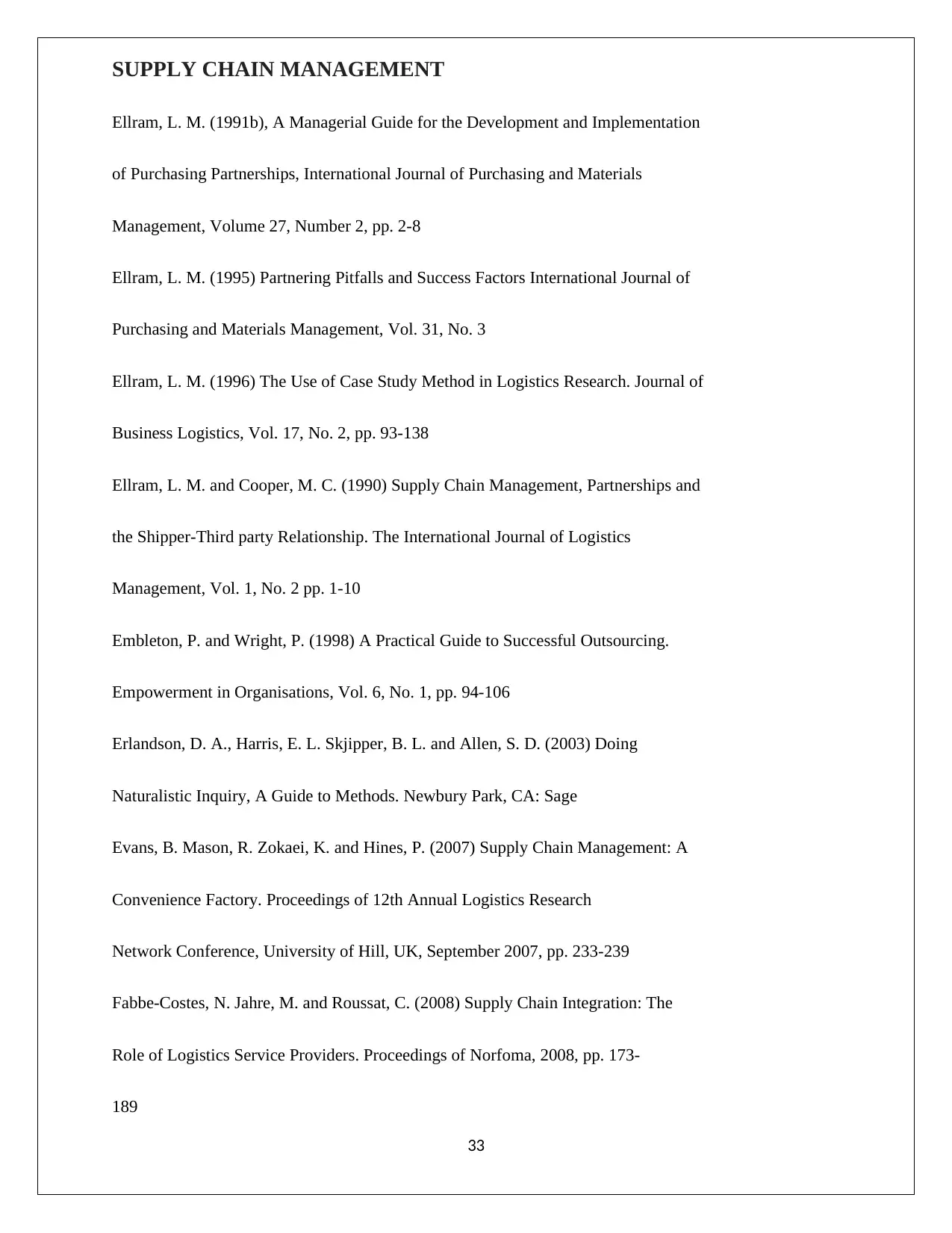
SUPPLY CHAIN MANAGEMENT
Ellram, L. M. (1991b), A Managerial Guide for the Development and Implementation
of Purchasing Partnerships, International Journal of Purchasing and Materials
Management, Volume 27, Number 2, pp. 2-8
Ellram, L. M. (1995) Partnering Pitfalls and Success Factors International Journal of
Purchasing and Materials Management, Vol. 31, No. 3
Ellram, L. M. (1996) The Use of Case Study Method in Logistics Research. Journal of
Business Logistics, Vol. 17, No. 2, pp. 93-138
Ellram, L. M. and Cooper, M. C. (1990) Supply Chain Management, Partnerships and
the Shipper-Third party Relationship. The International Journal of Logistics
Management, Vol. 1, No. 2 pp. 1-10
Embleton, P. and Wright, P. (1998) A Practical Guide to Successful Outsourcing.
Empowerment in Organisations, Vol. 6, No. 1, pp. 94-106
Erlandson, D. A., Harris, E. L. Skjipper, B. L. and Allen, S. D. (2003) Doing
Naturalistic Inquiry, A Guide to Methods. Newbury Park, CA: Sage
Evans, B. Mason, R. Zokaei, K. and Hines, P. (2007) Supply Chain Management: A
Convenience Factory. Proceedings of 12th Annual Logistics Research
Network Conference, University of Hill, UK, September 2007, pp. 233-239
Fabbe-Costes, N. Jahre, M. and Roussat, C. (2008) Supply Chain Integration: The
Role of Logistics Service Providers. Proceedings of Norfoma, 2008, pp. 173-
189
33
Ellram, L. M. (1991b), A Managerial Guide for the Development and Implementation
of Purchasing Partnerships, International Journal of Purchasing and Materials
Management, Volume 27, Number 2, pp. 2-8
Ellram, L. M. (1995) Partnering Pitfalls and Success Factors International Journal of
Purchasing and Materials Management, Vol. 31, No. 3
Ellram, L. M. (1996) The Use of Case Study Method in Logistics Research. Journal of
Business Logistics, Vol. 17, No. 2, pp. 93-138
Ellram, L. M. and Cooper, M. C. (1990) Supply Chain Management, Partnerships and
the Shipper-Third party Relationship. The International Journal of Logistics
Management, Vol. 1, No. 2 pp. 1-10
Embleton, P. and Wright, P. (1998) A Practical Guide to Successful Outsourcing.
Empowerment in Organisations, Vol. 6, No. 1, pp. 94-106
Erlandson, D. A., Harris, E. L. Skjipper, B. L. and Allen, S. D. (2003) Doing
Naturalistic Inquiry, A Guide to Methods. Newbury Park, CA: Sage
Evans, B. Mason, R. Zokaei, K. and Hines, P. (2007) Supply Chain Management: A
Convenience Factory. Proceedings of 12th Annual Logistics Research
Network Conference, University of Hill, UK, September 2007, pp. 233-239
Fabbe-Costes, N. Jahre, M. and Roussat, C. (2008) Supply Chain Integration: The
Role of Logistics Service Providers. Proceedings of Norfoma, 2008, pp. 173-
189
33
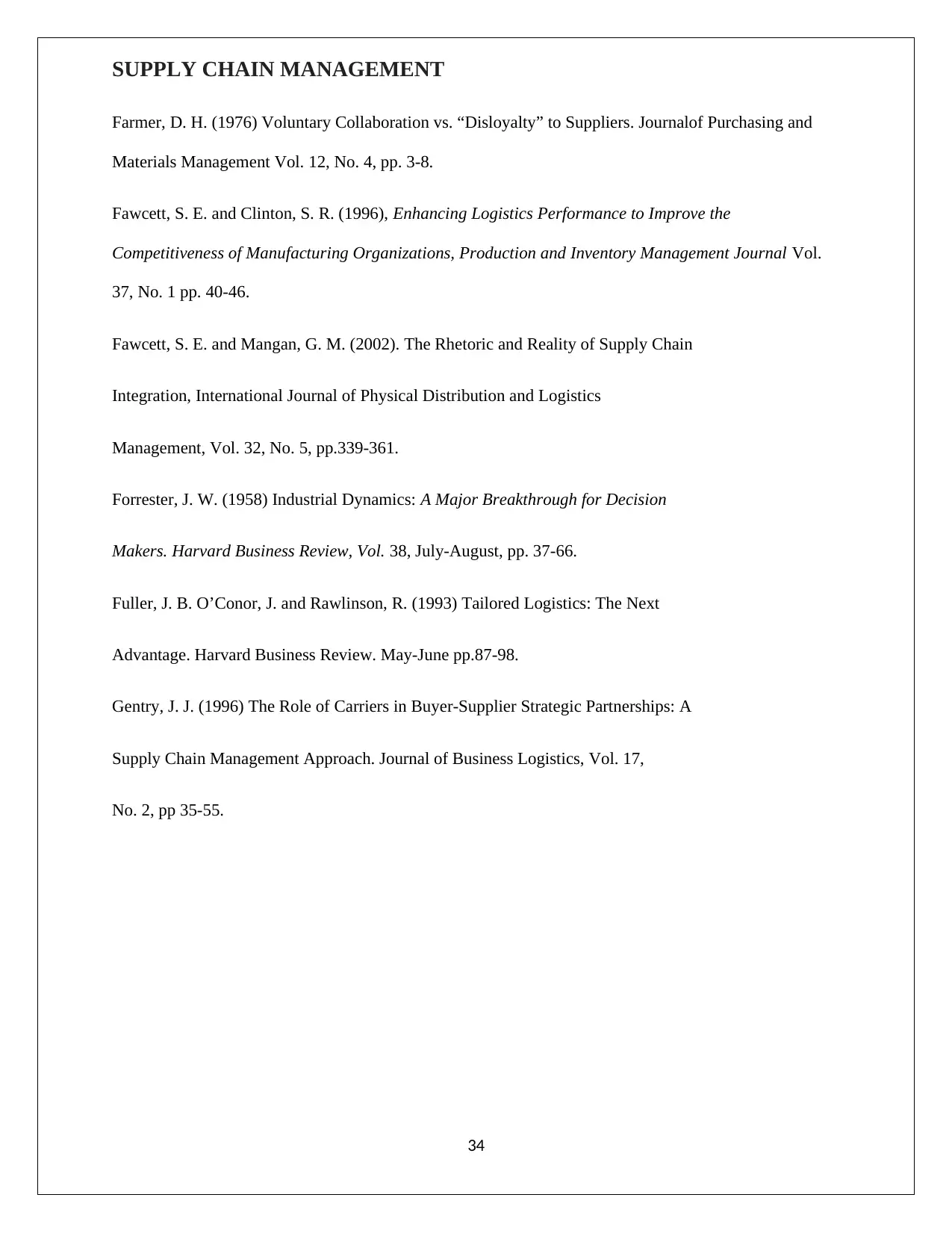
SUPPLY CHAIN MANAGEMENT
Farmer, D. H. (1976) Voluntary Collaboration vs. “Disloyalty” to Suppliers. Journalof Purchasing and
Materials Management Vol. 12, No. 4, pp. 3-8.
Fawcett, S. E. and Clinton, S. R. (1996), Enhancing Logistics Performance to Improve the
Competitiveness of Manufacturing Organizations, Production and Inventory Management Journal Vol.
37, No. 1 pp. 40-46.
Fawcett, S. E. and Mangan, G. M. (2002). The Rhetoric and Reality of Supply Chain
Integration, International Journal of Physical Distribution and Logistics
Management, Vol. 32, No. 5, pp.339-361.
Forrester, J. W. (1958) Industrial Dynamics: A Major Breakthrough for Decision
Makers. Harvard Business Review, Vol. 38, July-August, pp. 37-66.
Fuller, J. B. O’Conor, J. and Rawlinson, R. (1993) Tailored Logistics: The Next
Advantage. Harvard Business Review. May-June pp.87-98.
Gentry, J. J. (1996) The Role of Carriers in Buyer-Supplier Strategic Partnerships: A
Supply Chain Management Approach. Journal of Business Logistics, Vol. 17,
No. 2, pp 35-55.
34
Farmer, D. H. (1976) Voluntary Collaboration vs. “Disloyalty” to Suppliers. Journalof Purchasing and
Materials Management Vol. 12, No. 4, pp. 3-8.
Fawcett, S. E. and Clinton, S. R. (1996), Enhancing Logistics Performance to Improve the
Competitiveness of Manufacturing Organizations, Production and Inventory Management Journal Vol.
37, No. 1 pp. 40-46.
Fawcett, S. E. and Mangan, G. M. (2002). The Rhetoric and Reality of Supply Chain
Integration, International Journal of Physical Distribution and Logistics
Management, Vol. 32, No. 5, pp.339-361.
Forrester, J. W. (1958) Industrial Dynamics: A Major Breakthrough for Decision
Makers. Harvard Business Review, Vol. 38, July-August, pp. 37-66.
Fuller, J. B. O’Conor, J. and Rawlinson, R. (1993) Tailored Logistics: The Next
Advantage. Harvard Business Review. May-June pp.87-98.
Gentry, J. J. (1996) The Role of Carriers in Buyer-Supplier Strategic Partnerships: A
Supply Chain Management Approach. Journal of Business Logistics, Vol. 17,
No. 2, pp 35-55.
34
1 out of 34
Related Documents
Your All-in-One AI-Powered Toolkit for Academic Success.
+13062052269
info@desklib.com
Available 24*7 on WhatsApp / Email
![[object Object]](/_next/static/media/star-bottom.7253800d.svg)
Unlock your academic potential
© 2024 | Zucol Services PVT LTD | All rights reserved.





